Nowadays, you can frequently see people „flying“ over the water. Some using a kite, some others a wing, … and then there are some only propelled by the movement and energy of the rider – the pumpfoilers.
Pumpfoiling has become more and more popular and more often you can spot them „flying“ with a board over the water.
In 2023, we have done our second pumpfoiling survey and based on the results, could see how the sport is further developing. In this years follow-up survey, we wanted to find out more about community and its development, e.g. how difficult pumpfoiling is, how dangerous it can be and for sure, also to find out what the community recommends to newbies in pumpfoiling. Comparing the results with the previous years surveys is also providing some insights, how the sport is developing.
The survey was conducted in July and August 2024, with 105 people participating in it.
Survey participants
Overall, 105 people participated in the survey. The survey was open for anyone, means also people who practice and people who do not (yet) practice pumpfoiling. 94% of the participants mentioned that they practice pumpfoiling.
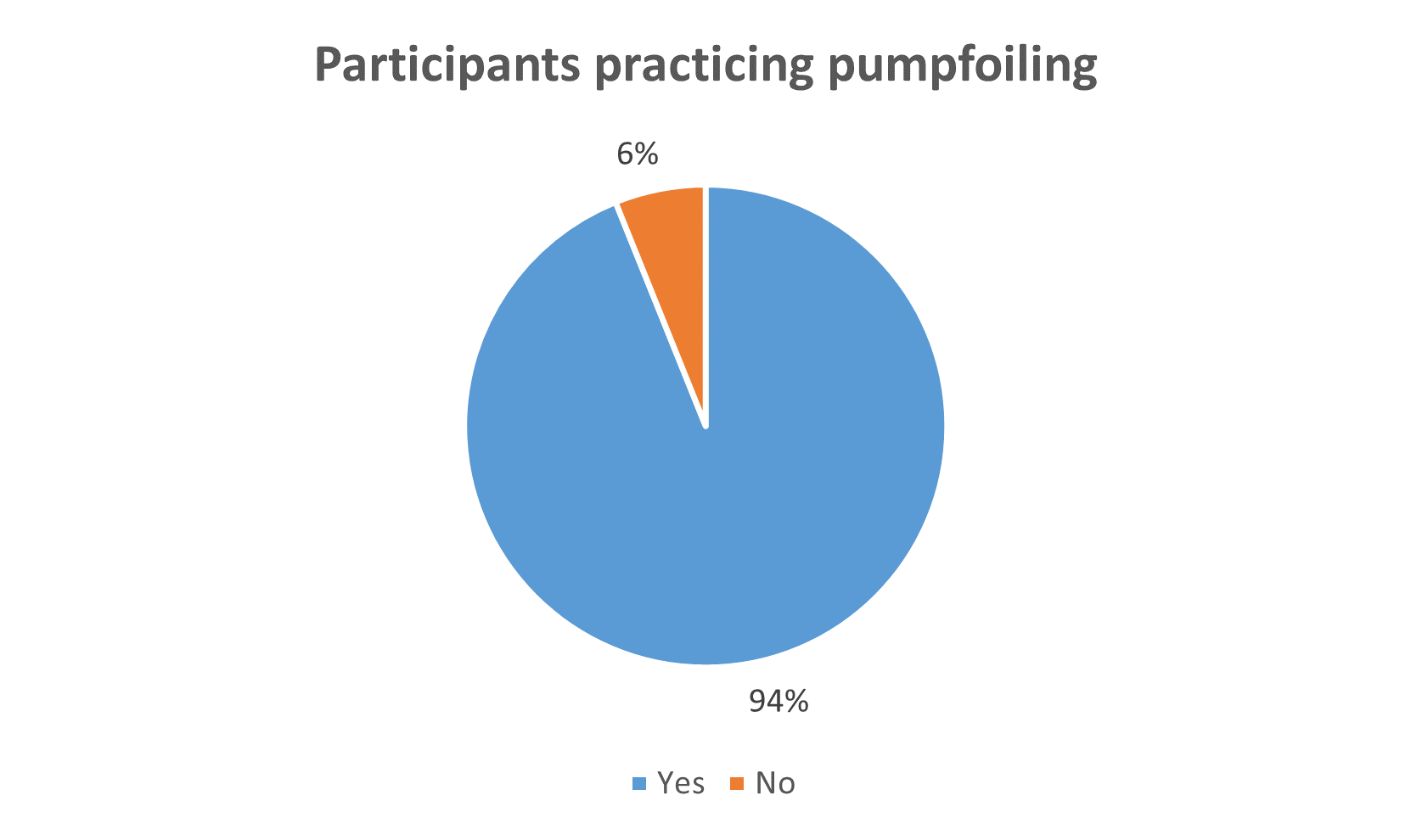
Those of you who from time to time observe pumpfoilers doing their dockstarts at the water will know, that pumpfoiling is a sport for everyone. In our survey, 8% of the participants were female, 91% male and 1% non-binary.

As pumpfoiling is still a young sport, many people may are tempted to say that pumpfoiling is only for young people. But looking at the age of the pumpfoilers who took part in the survey, we can see that pumpfoiling is a sport for any age.
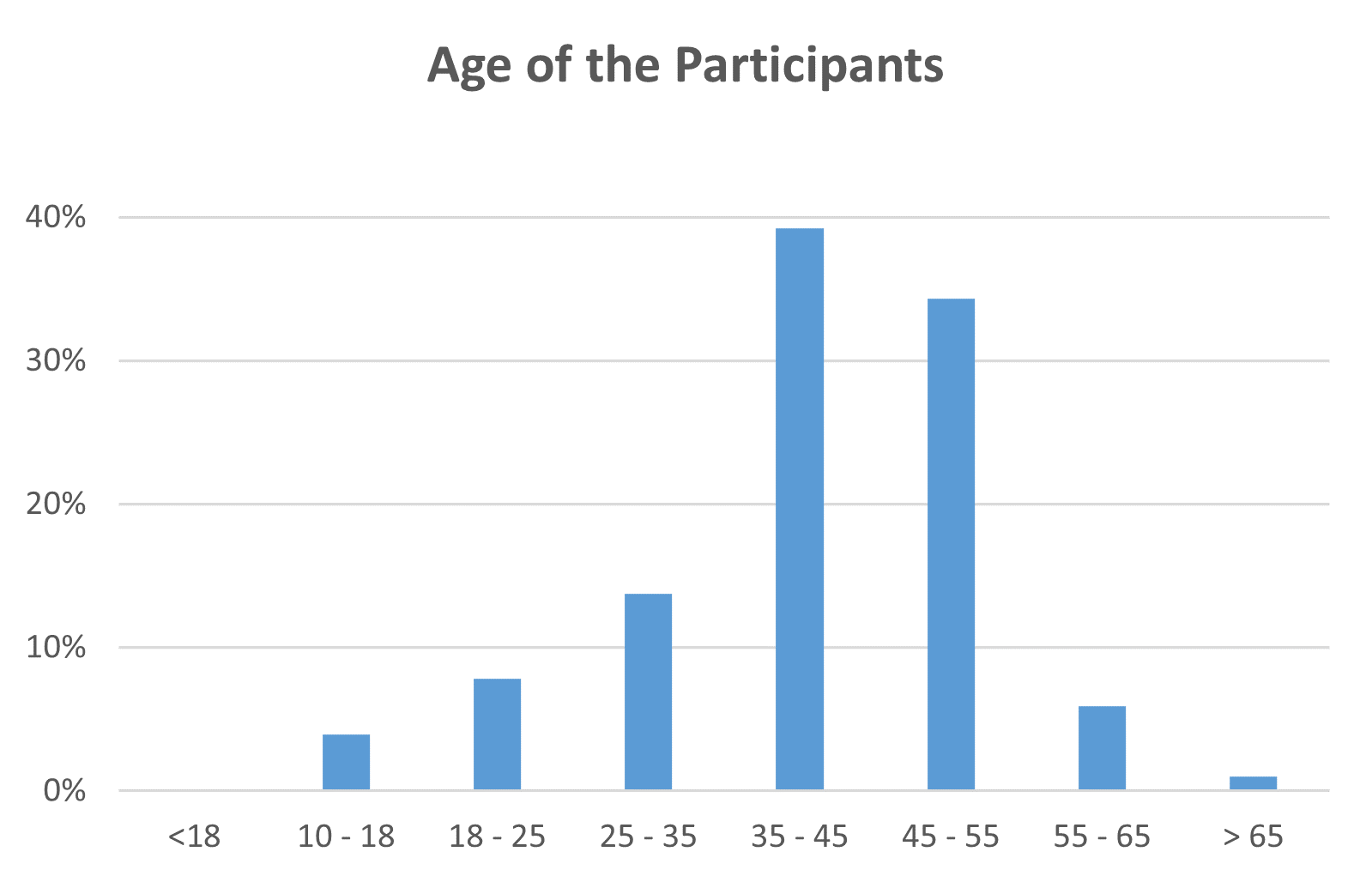
Before we are going into more details about the feedbacks we received, we also would like to have a quick look where the survey participants are located. That may relevant, as we will also look into questions related to the equipment they are using. We would like to highlight, that the results may not be representative for some of the questions, e.g. as some material/brands are not available in all countries.

Pumpfoiling something new?
Pumpfoiling is not anymore a completely new sport. But as we can conclude from the distribution, when the people did their first attempts, we can see that the sport is still growing. Also we can see, most people are starting with pumpfoiling in the months between April and September (please note that 97% of the survey participants are from Europe). However, also quite a few do their first attempts in the colder time of the year.
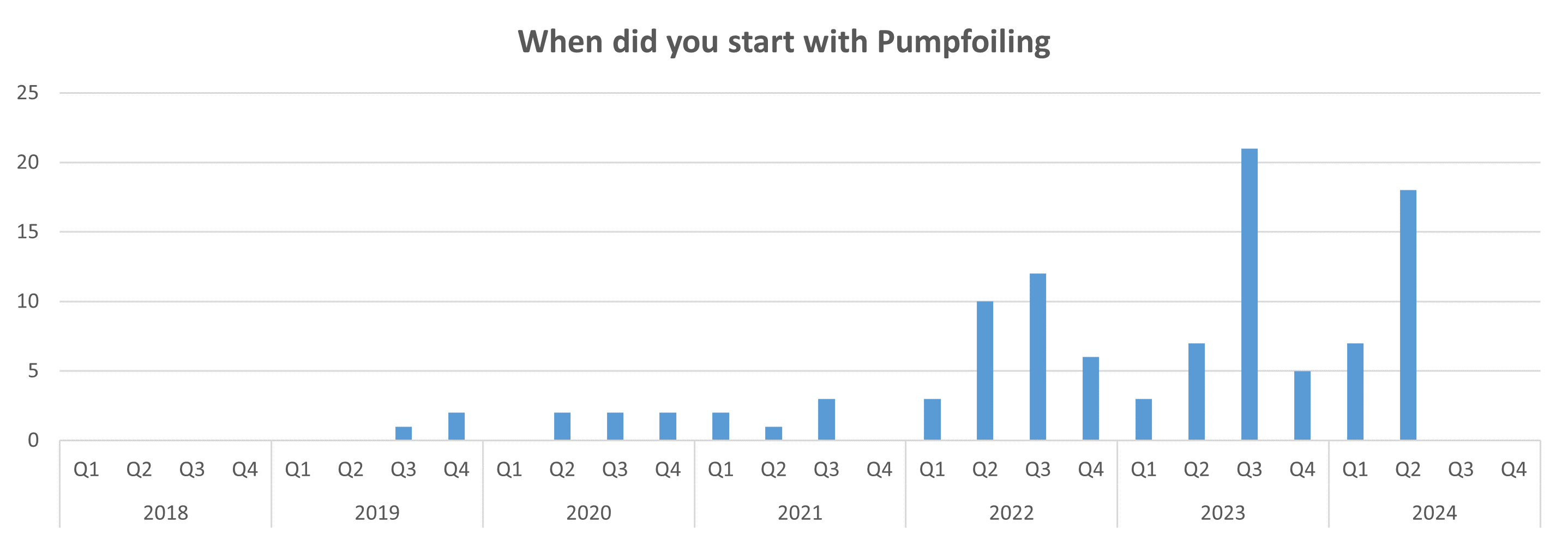
How did you first time hear about pumpfoiling?
22% of the pumpfoilers responded, that they heard first time about pumpfoiling via Instagram, followed by 21% stating that either a friend told them about pumpfoiling or that they spotted a pumpfoiler practicing the sport. 27% responded with ‚other‘ how they first time heard about pumpfoiling.
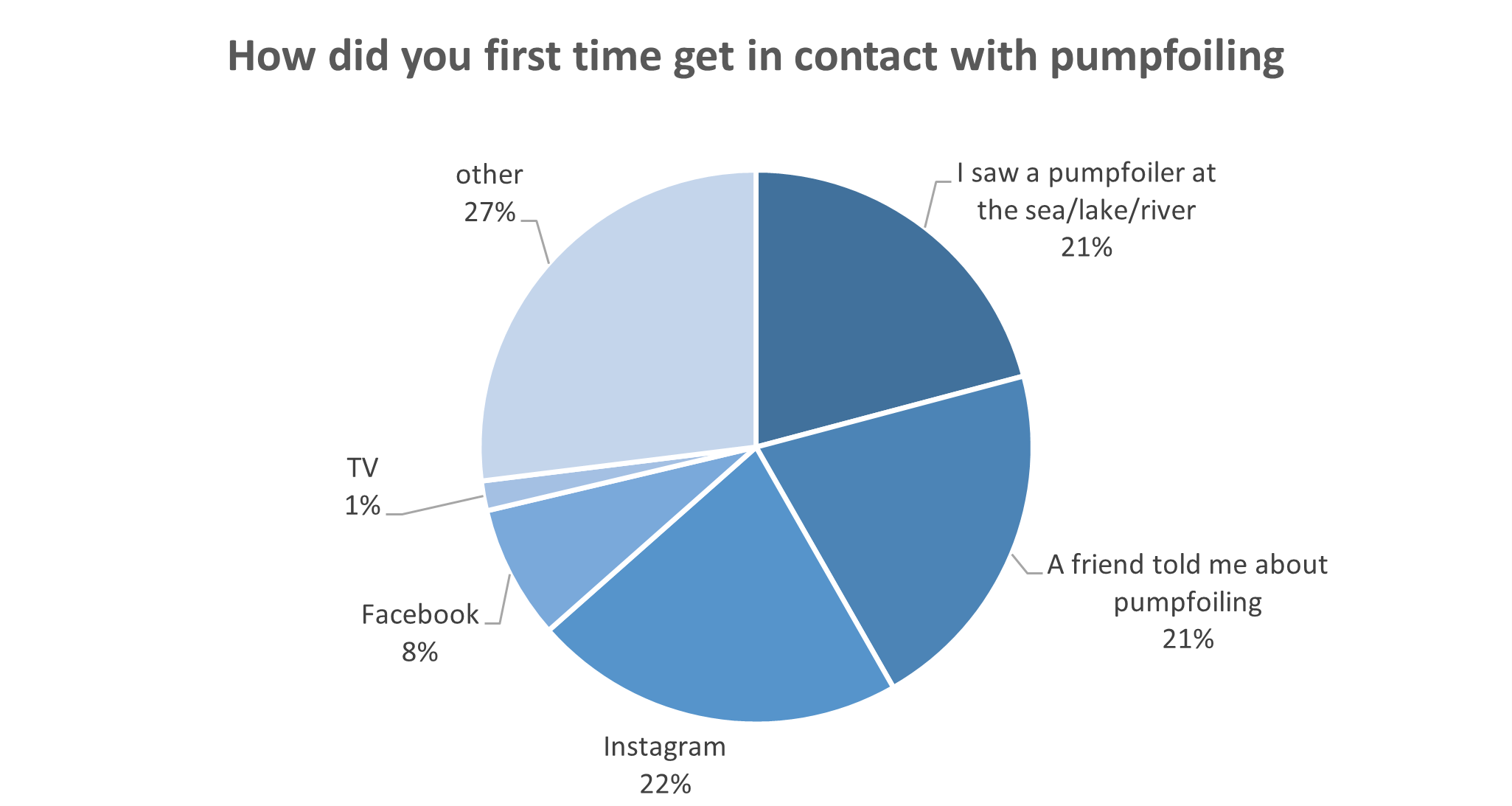
Comparing with last years results, we can see that the channels how people get first time in contact with pumpfoiling remain quite stable.
How difficult is pumpfoiling?
One of the most posed question at the dock by people who have never tried it by themselves is „how difficult is pumpfoiling“? Before looking a little bit more into the details of that question, let us first have a quick look how the survey respondents judge their own pumpfoiling skills.
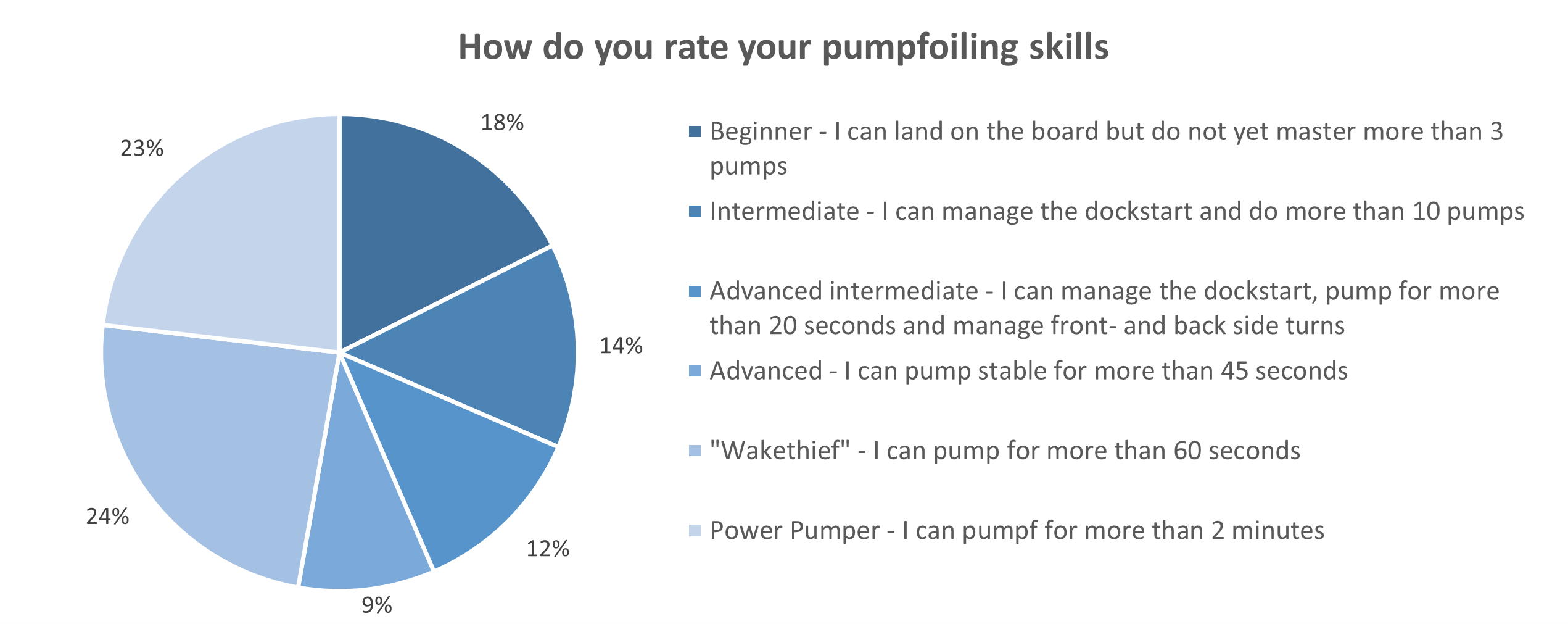
69% of the participants judge their pumping skills as “advanced intermediate” or better. But how much effort does it require to master Pumpfoiling? How many times do you have to fail until you can enjoy flying over the water? For sure, it is not a sport you try once and after the first session you will be a ‘master-pumper’.
We asked the question „how many attempts did it take you to learn pumpfoiling (means you can start and pump for approx. 30 seconds)?“
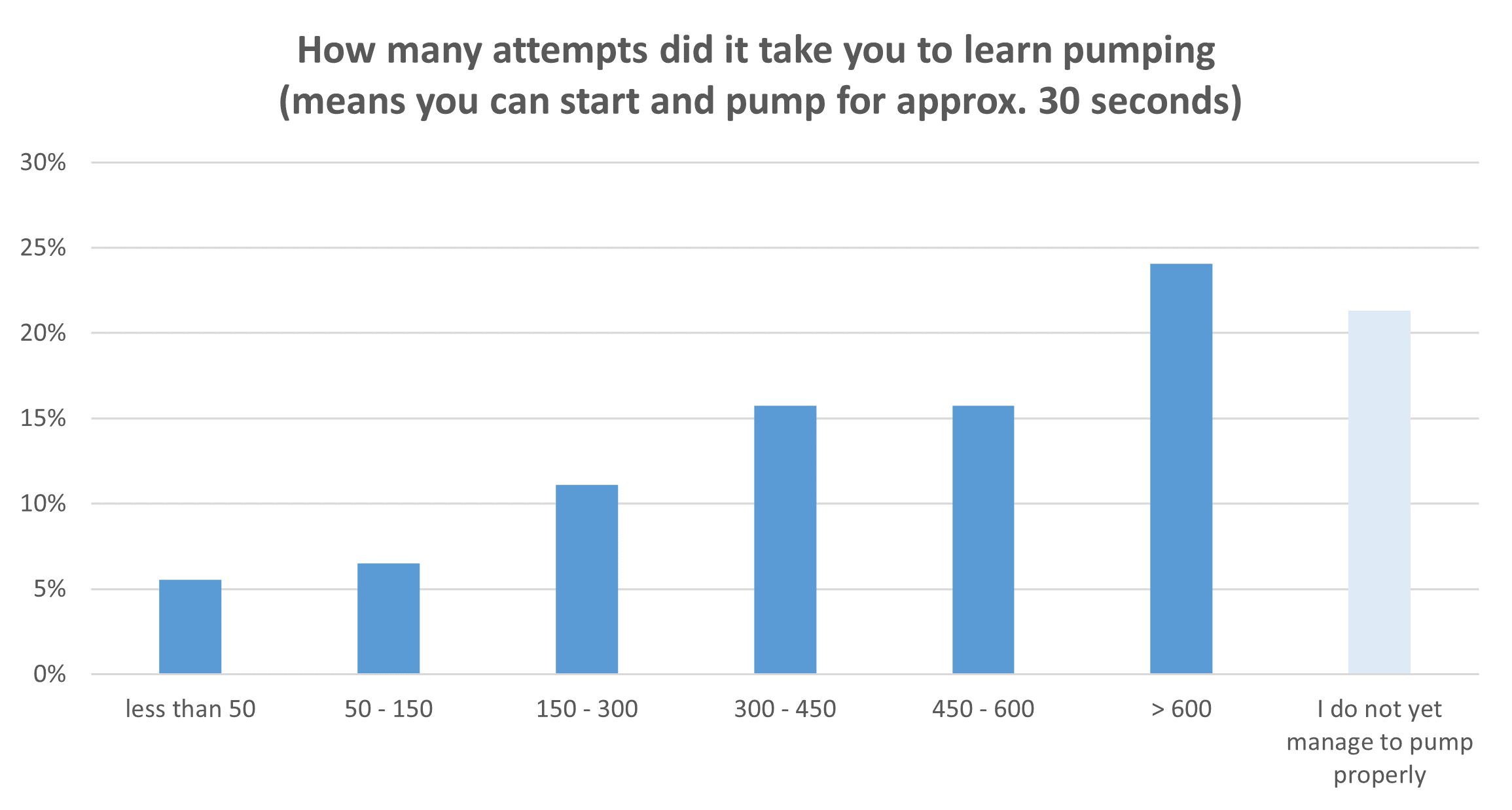
Most survey participants responded that it takes between 300 and 600 attempts to learn Pumpfoiling. Interesting is to see the development from last years survey results.
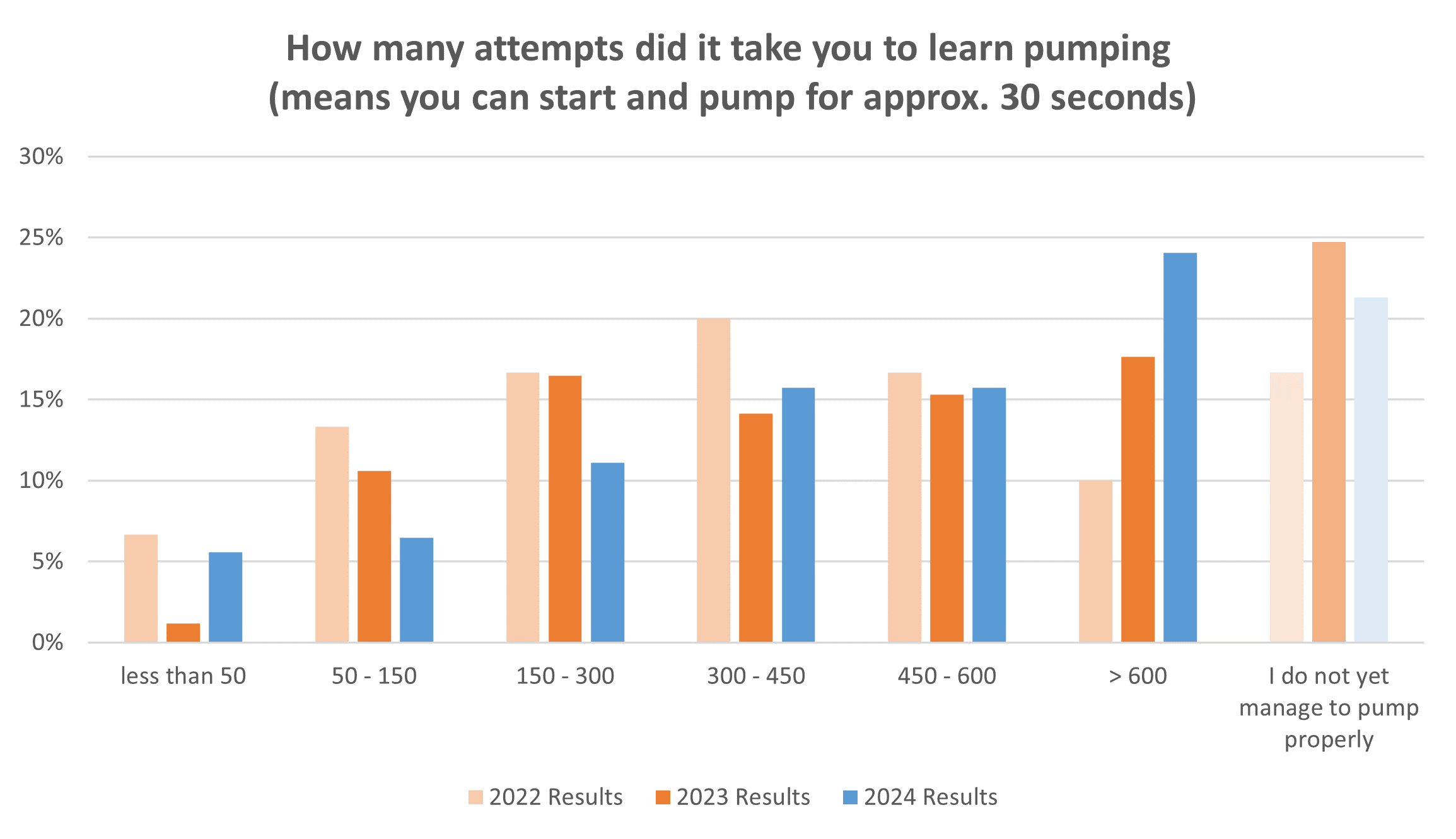
Taking the weighted average and counting therein the number of attempts of participants mentioning that it took them more than 600 attempts with 600 attempts, we can see that in the 2022 survey, the average number of attempts was 330 attempts, in 2023 381 attempts and in 2024 405 attempts.
We do not want to speculate too much about what are the reasons that the number of attempts it takes to learn pumpfoiling are increasing. One reason could be that the participants just differently estimate how many attempts it takes, as many will not maintain a detailed logbook. Another reason could be that pumpfoiling develops more into a grassroots sport and the ones did their first attempts already 2 or 3 years ago, had already experience with other foiling sports.
Besides asking the participants about their number of attempts, we also asked them in terms of time how long it took them learn pumpfoiling. Obviously, this will depend on the number of attempts you do per session as well as on how often you practice pumpfoiling.
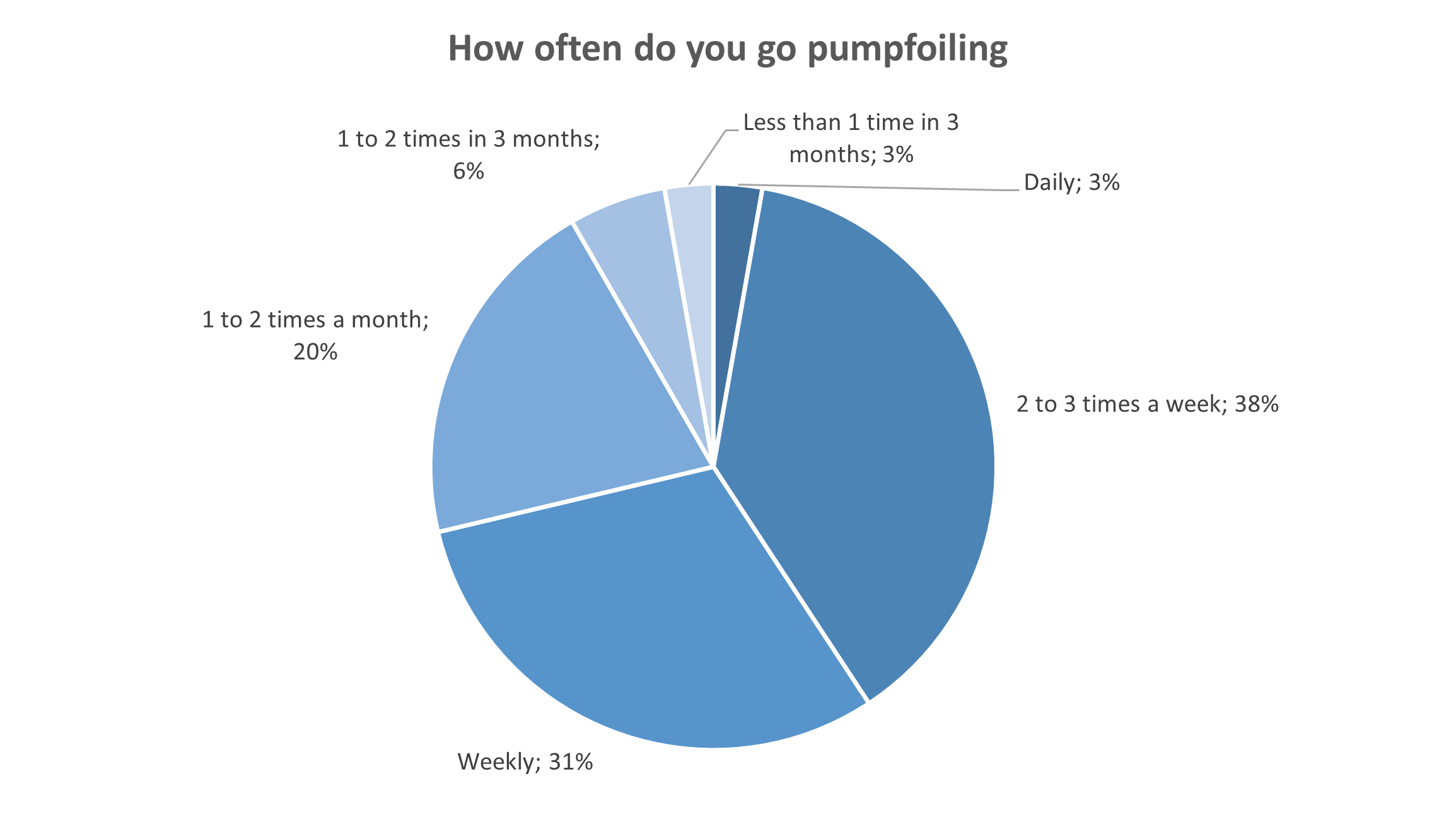
72% of our pumpfoiling survey participants mentioned that they go at least once a week for a pumpfoiling session. Only very few mentioned, that they can practice pumpfoiling less than once a month.
Coming back to the question how difficult it is to learn pumpfoiling and how much time it takes, we asked in the survey also how long it took them to become a „Wakethief“ in terms of months.
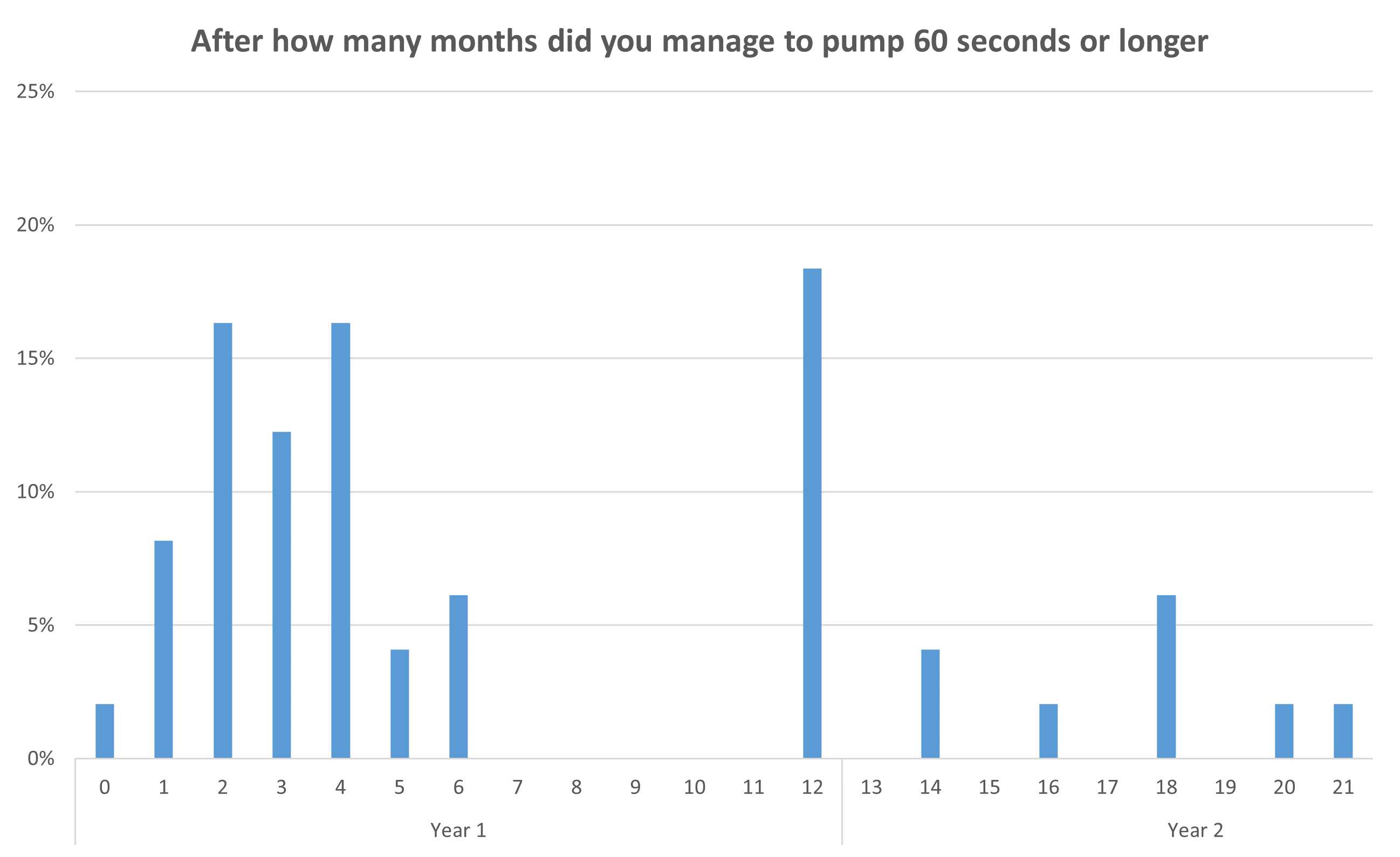
What is the preferred dockstart method of the survey participants?
It doesn’t matter if you watch YouTube videos, watch reels on Instagram or observe pumpfoilers at the sea or lake: You will see that there are different start techniques. Whereas some are standing still, give a gentle push to the board and then jump directly from standing onto the board, some others run a few steps and then jump onto the board. Another method you can observe is what we call the „drop start‘. Thereby, you drop the foil into the water and then jump on the board. That technique you can often observe when pumpfoilers are using higher docks, where it is difficult to submerge the foils in the water while standing on the dock. Last but not least, also some use dockstart devices, means using a fixation that holds the board and you then run and jump on the board.
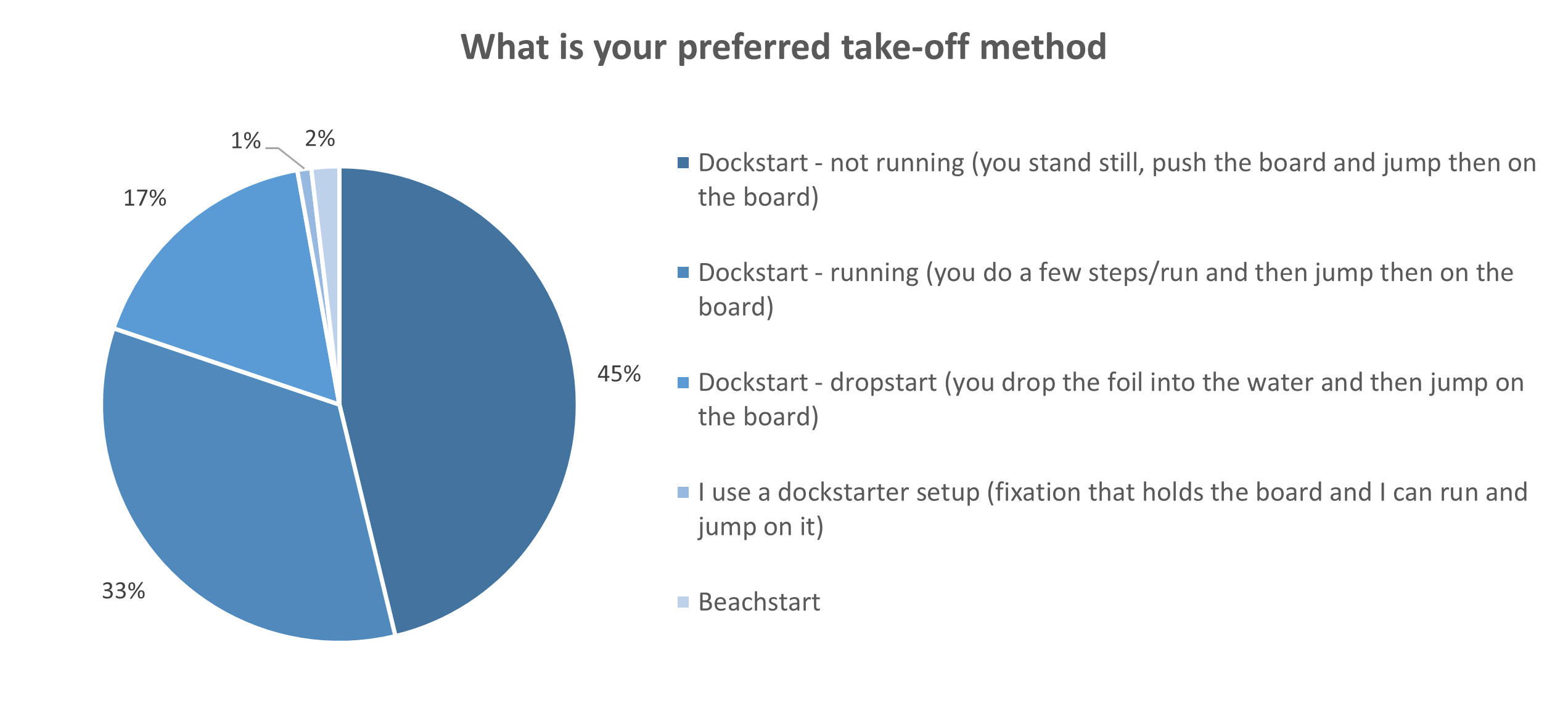
Locking at the responses from our survey participants, most use the running start or start jumping from the stand onto the board.
Comparing with last years results, we can see that percentage wise less people are doing the running start (last year result 46%) and slightly more people the dropstart (last year result 12%). The number of people doing the dockstart with jumping from the stand has also slightly increased compared to last year (last year result 41%).
Which starting technique you use will at the end be dependent on the location and personal preferences. If one or the other technique is more or less difficult is not that simple to answer. However, we compared the dockstart techniques of our participants with their answers about how many attempts it took them to learn pumpfoiling.
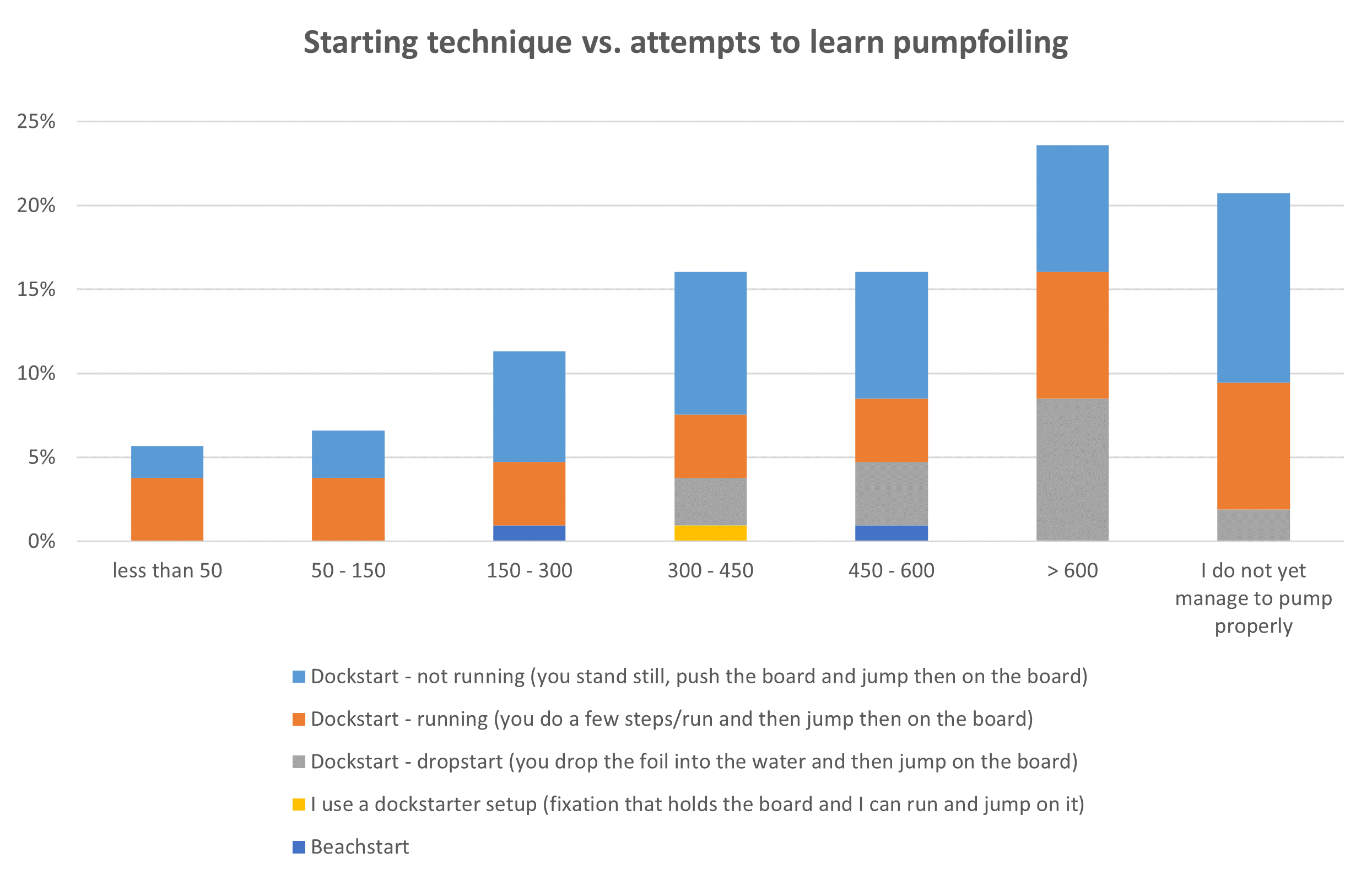
Based on the answers we received it seems that the dropstart is slightly more difficult than the running start or start with jumping sidewards from the stand onto the board. As only very few are using a dockstarter device respectively doing the beachstart, it is difficult to make a final statement about those starting techniques in view of if they are more or less difficult to learn pumpfoiling.
What is the longest pumpfoil run?
A common question at the dock is how long you can pumpfoiling respectively what is the longest run you have ever done?
Well, the first hurdle you have to overcome is for sure to successfully master the dockstart. But once you managed that, many pumpfoilers will work on the endurance and try to do longer and longer runs. With new equipment being developed, also new records are set. At the time of doing this survey, the record was 4hrs and 2min.
Looking at the participants in our survey, the average time of the longest run is 259 seconds (4 minutes 19 seconds) and the median is 53 seconds.
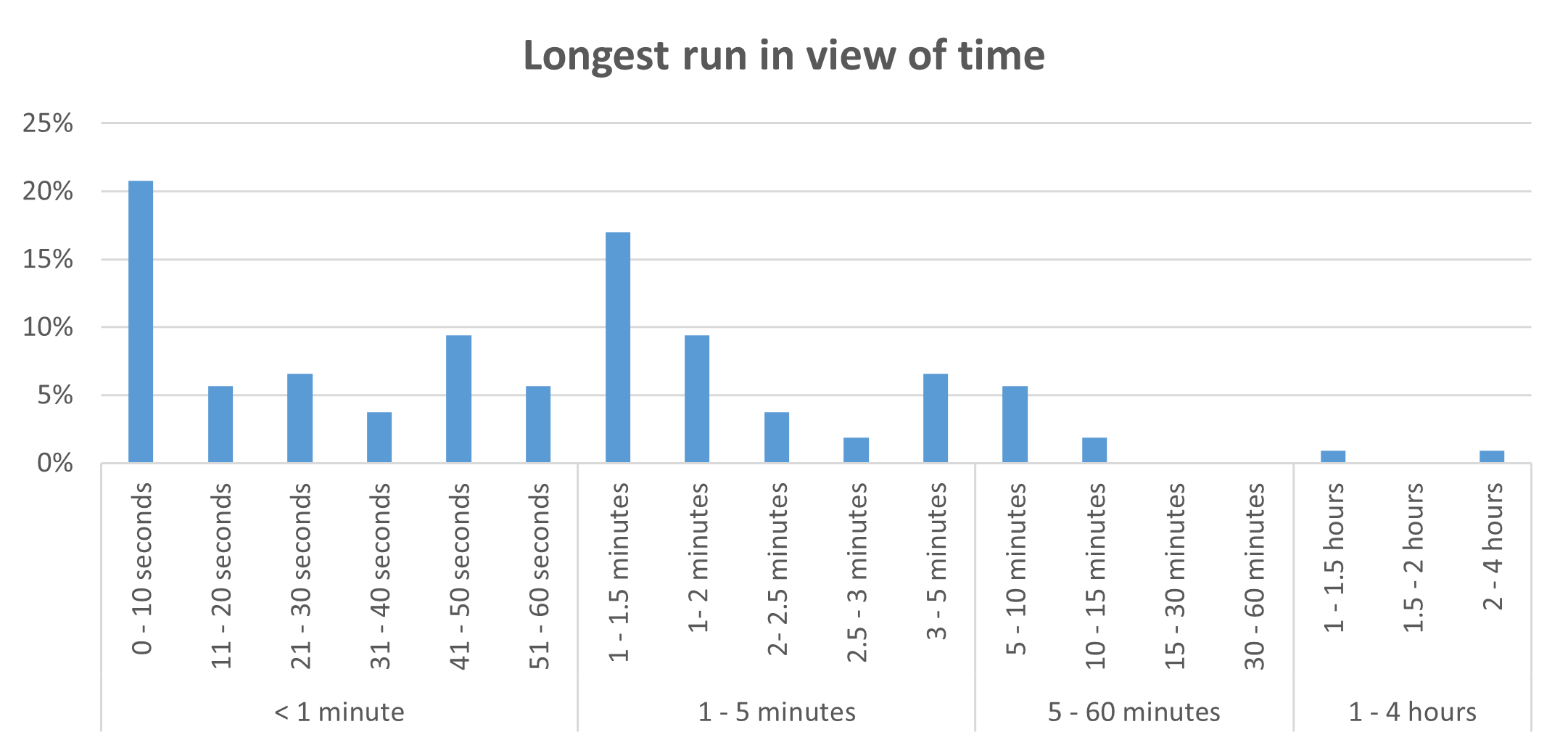
Meeting other foilers at the dock and talking about how long thir longest pumpfoil rounds are, they also ask the question about the foil brand and model. As we only have a limited number of survey participants in comparison to the number of different brands, we were not sure, if we should publish the following evaluation. However, we then thought it is still good to see, that there is a big diversity of brands and foils in the market and you can with many of them also achieve longer pumpfoil rounds.
The following graph just represents, what brand the foil is with that the survey participants have done their longest run. As mentioned, please do not take the conclusion that longest run is correlating purely with the foil brand. It is still the rider that ‚puts the technique and energy into the equation‘ 🙂
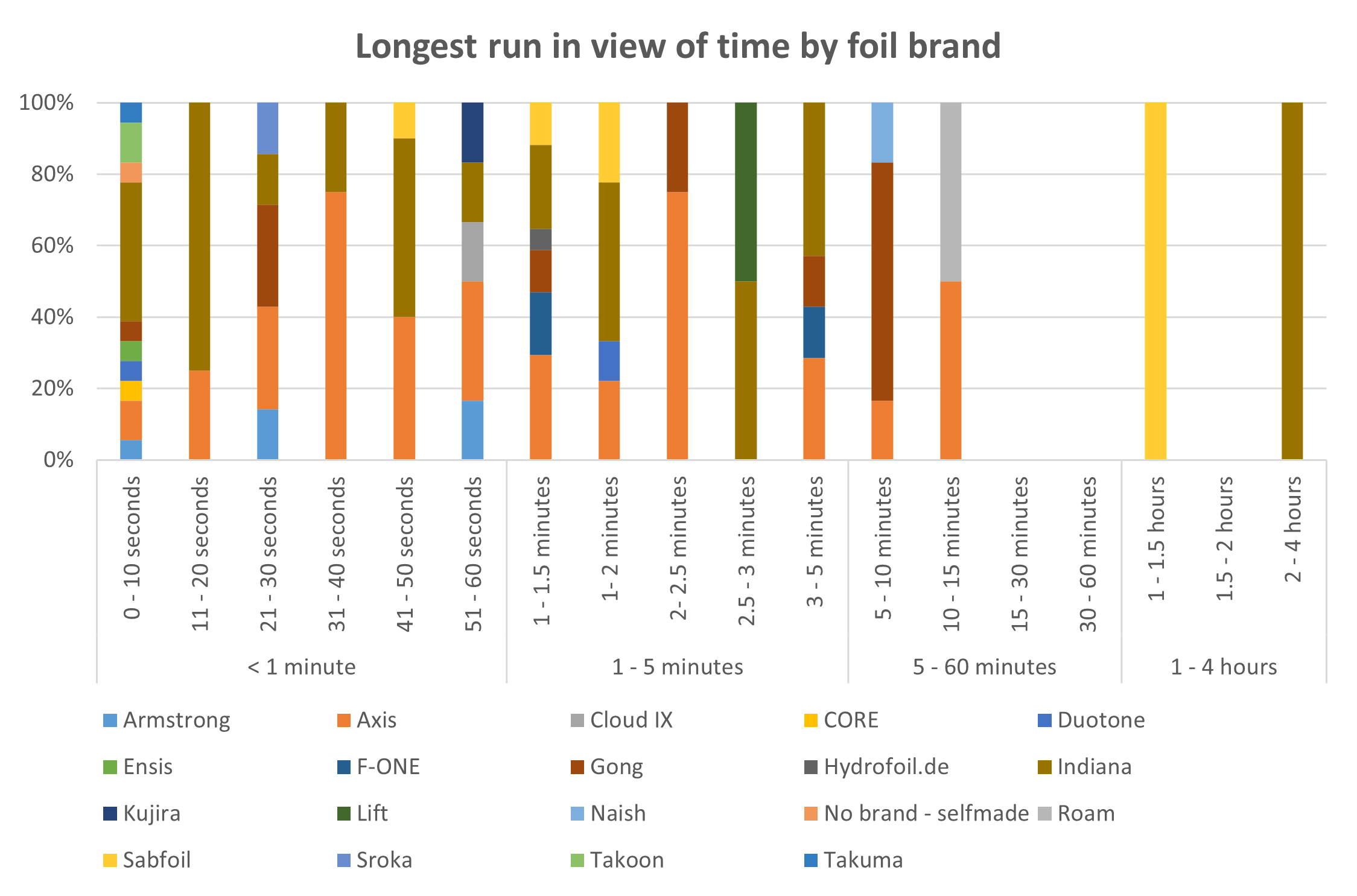
That also leads us then to the next section about the equipment.
Equipment
I guess that most of you agree, that sooner or later in any discussion about foil pumping the topic equipment comes up. Therefore, we were also interested to find out a little bit more about the equipment used by the participants of this survey.
Before we are going to dig into more details about the equipment the survey participants use, let us check how many of them have their own equipment and because of that, already had to make a decision for a brand and model.
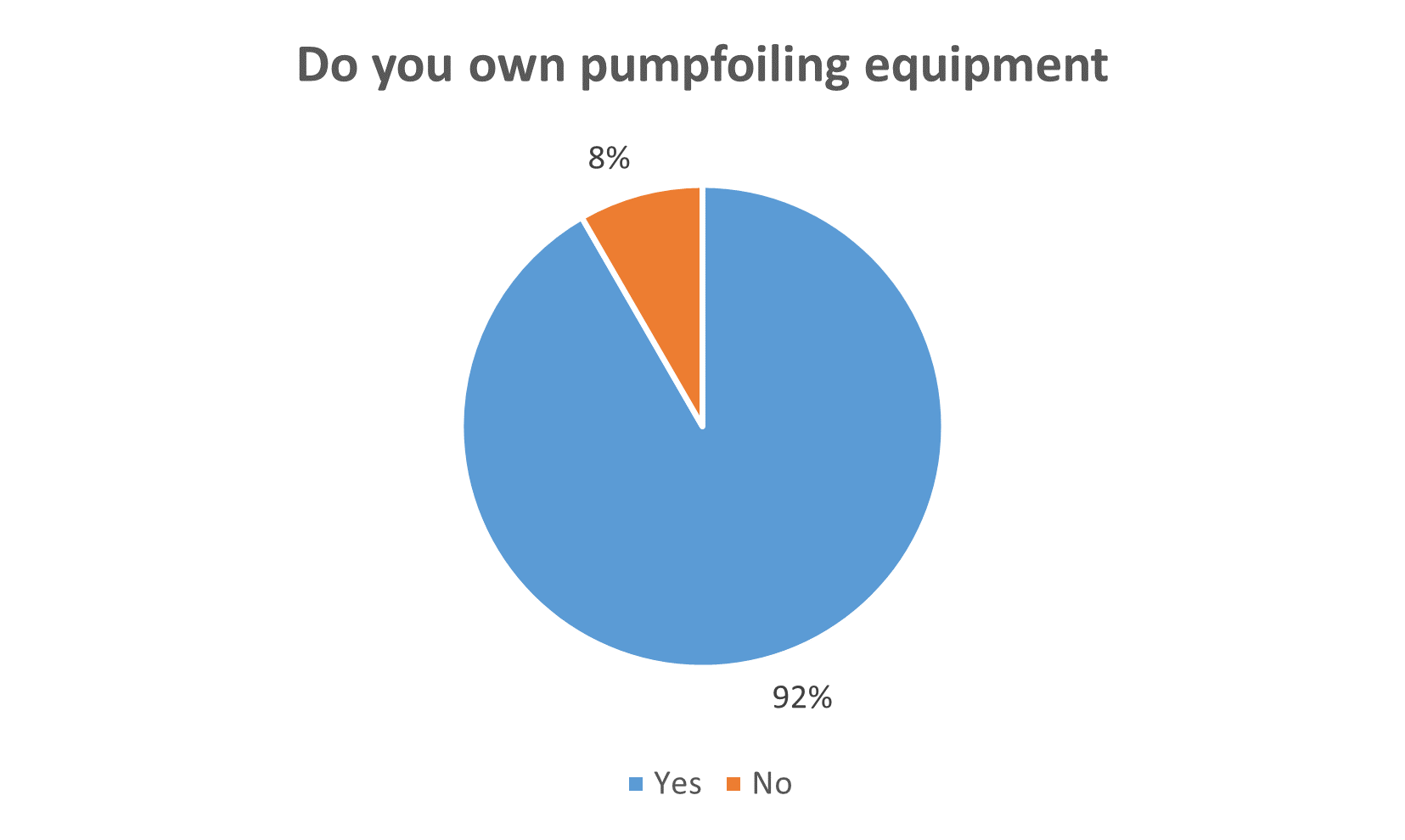
Most of the people who participated in the survey have their own equipment. Although that there are nowadays more and more stores and schools offering to borrow pumpfoiling equipment it worth for people practicing regularly to invest into their own setup.
There are many different brands and models in the market. Looking at the previous question about how they got in contact with Pumpfoiling, we may also have to consider that the decision for the equipment is – besides other factors – also influenced by what equipment the colleagues are foiling with. In addition to that some brands are more popular than others, dependent in which country live. Please keep in mind that 97% of the participants in this survey are located in Europe. Nonetheless, the variety of the boards and foils used by the survey participants is remarkable.
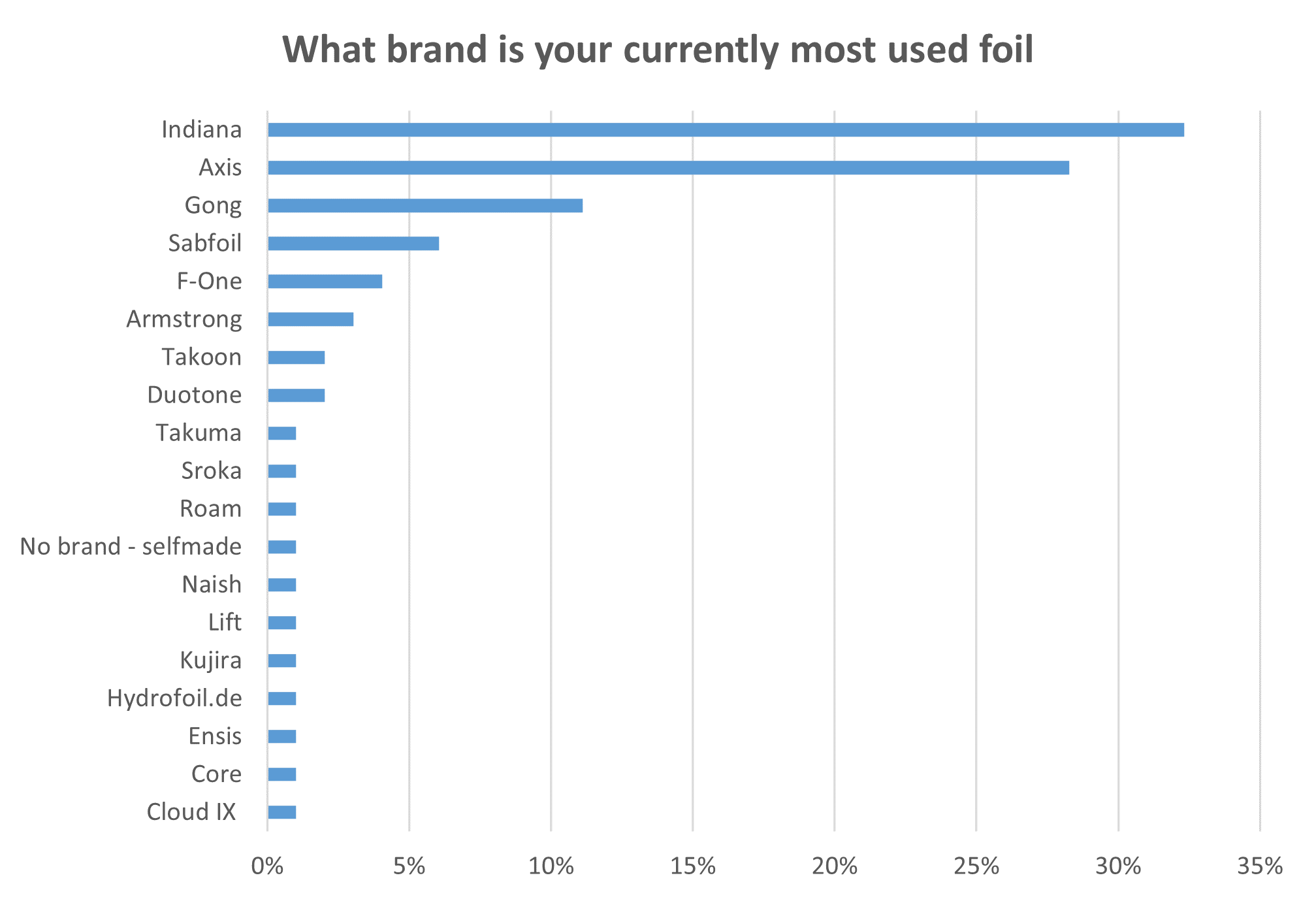
Looking at the brand of the board, there is also a big variety of brands represented. Also remarkable here is that there are many self made boards. Please note that also what is listed here as „Coalsurfco“ are boards made by an individual person in his own little workshop.
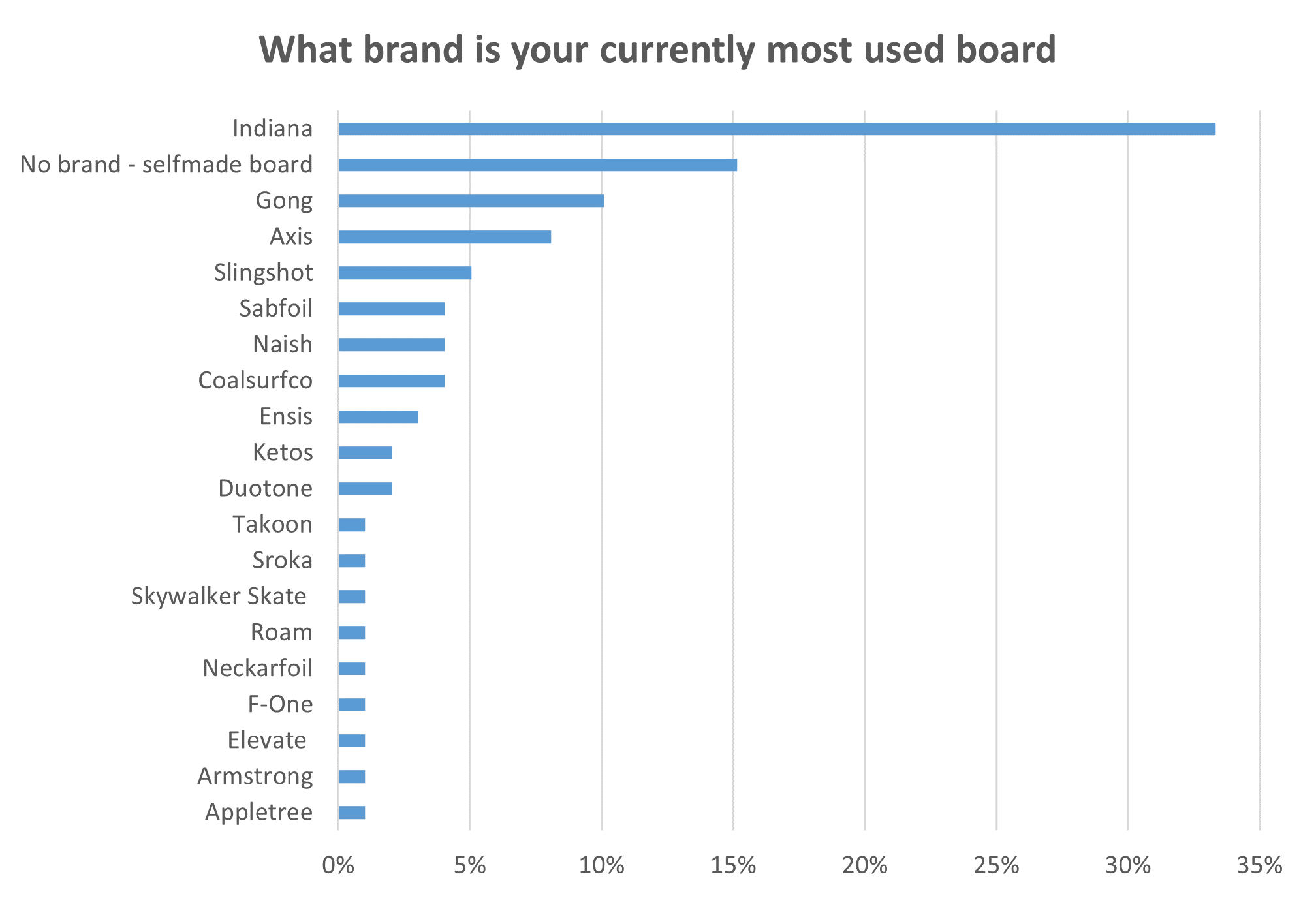
But the brand is only one aspect. Most brands have nowadays quite some selections of different frontwings in their portfolio. Therefore, let us check which models are used by our survey participants.
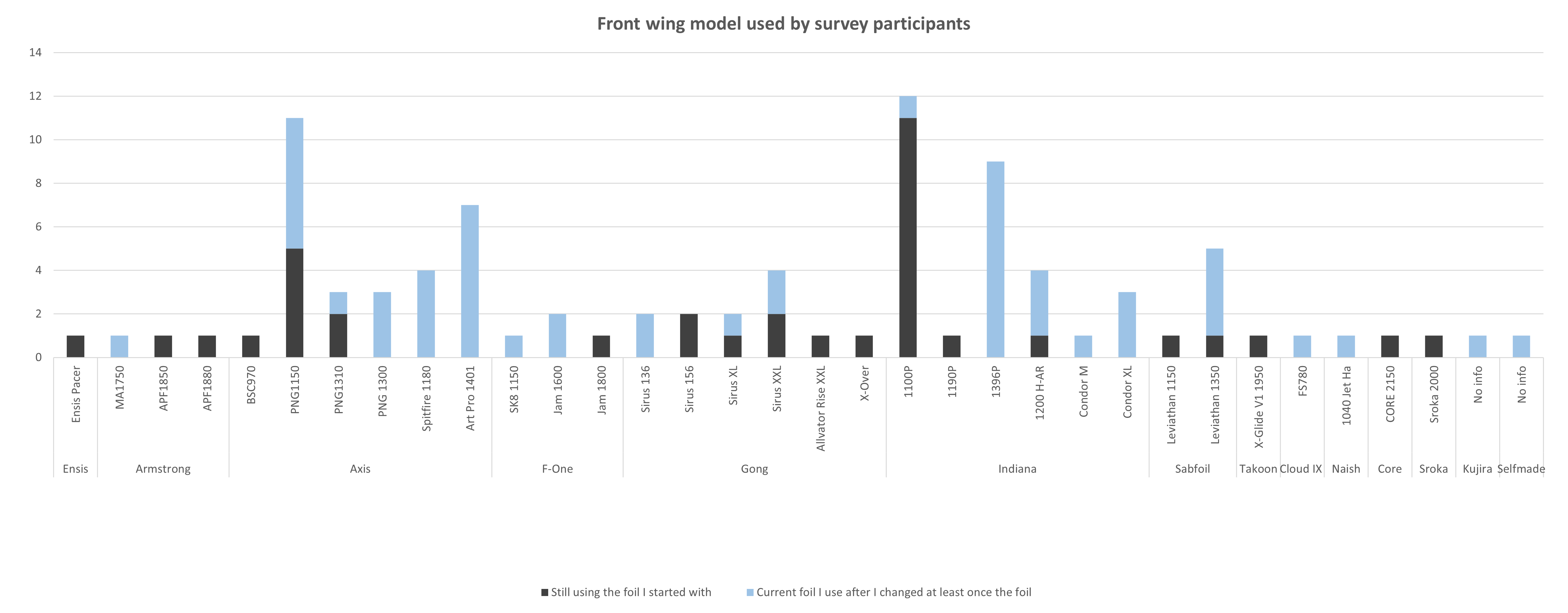
In the diagram above we show the frontwing model the participants mentioned they are currently using the most.
Please note, that the frontwing model was a free text field and therefore, not all foils could be 100% matched to foils you may find online.
As we were asking which foil they are using today most often, we marked the feedbacks in light blue colour, when the participant is not anymore using the foil she or he started to learn pumpfoiling with.
One of the big questions is always, what foil is suitable for a beginner to learn with. There is no right or wrong as a foil always has to match the riders weight, skills and also personal preferences. But will show you which foils the survey participants use dependent on if they judge their skills level as beginner or intermediate foiler, means the group of respondents who classifies themselves as „Beginner – I can land on the board but do not yet master more than 3 pumps „ or „Intermediate – I can manage the dockstart and do more than 10 pumps“, as well as advanced pumpfoilers, means that group of respondents that classifies themselves as either „Advanced intermediate – I can manage the dockstart, pump for more than 20 seconds and manage front – and back side turns“, „Advanced – I can pump stable for more than 45 seconds“, „Wakethief“ – I can pump for more than 60 seconds“ or „Power Pumper – I can pump for more than 2 minutes“.


Most pumpfoilers will sooner or later also change their foil, means changing from a beginner friendly foil to a more advanced foil. Looking at the responses in our survey 59% already have changed the foil.

For sure, there are also foilers that start with a foil, however then realize that the foil the started with is not suitable to really learn pumpfoiling. So let us dig in a little bit more into that topic who and when they change the foil.
Most of the participants who judge their level as beginner or intermediate have not yet changed the foil. That however changes quickly, the longer runs they do.

Very often beginners ask me, for how long can I use a beginner foil, in case I decide to buy one. Well, there is obviously no precise answer to that question. Changing the foil means often that you wnat to have a faster, more agile foil or a foil with that you can pump longer distances. The compromise you have to go for is then, that the start is often not as easy as with a beginner friendly foil. On the other hand, the more advanced foils come with less resistance (drag) which then allows a more relaxed pumping.
Looking at the results from the survey, we can see that most of the survey participants have changed their foil within the first 12 months.
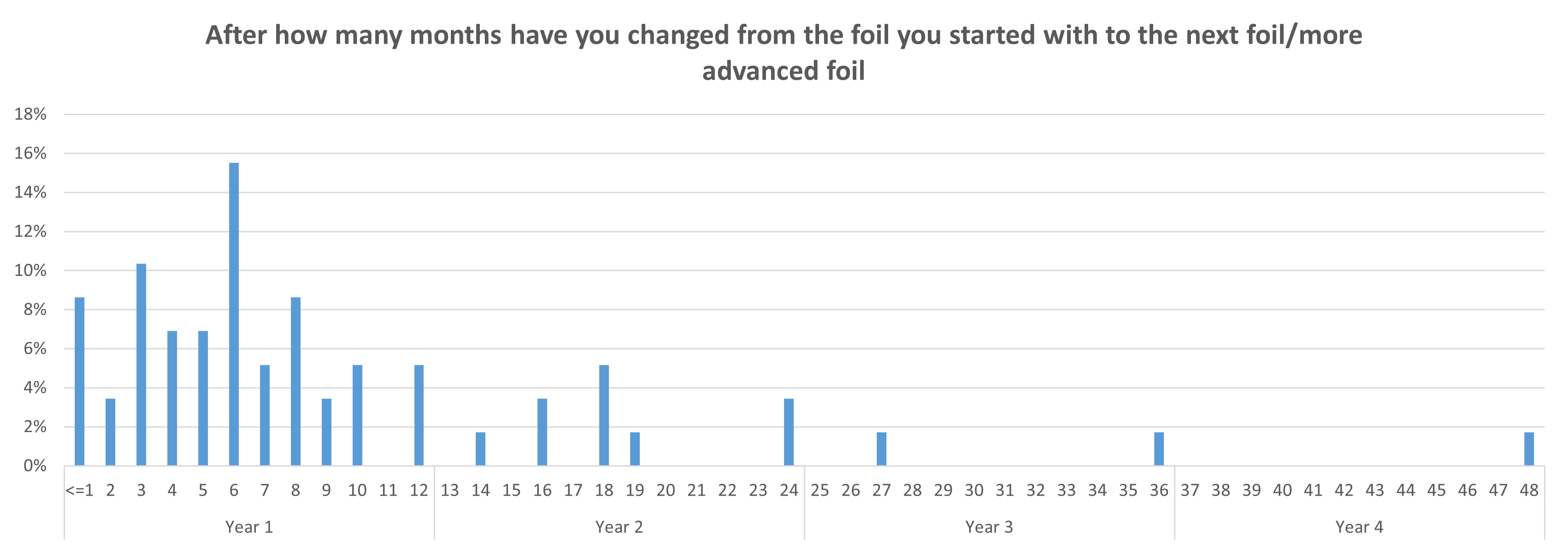
Looking that result, we obviously have to consider that the question „after how many months“ is not considering how often you go pumpfoiling. As we have seen in one of the previous question, there are pumpfoilers who go more or less daily pumpfoiling and others who barely find time to go foiling. Therefore, we asked the same question but in terms of sessions.

The median of the results shows that people change their beginner foil after 6 months, what is quite similar to last years result where the median was at 5 months.
When changing the foil, everyone also has to ask her/himself if you want to stay with the brand or not. As the compatibility of the components is limited, a change of hte brand is coming in most cases with a higher price tag, than just replacing e.g. the front- an backwing. Nevertheless, we can see 52% of the foilers who already replaced the foil, decided also to change the brand.
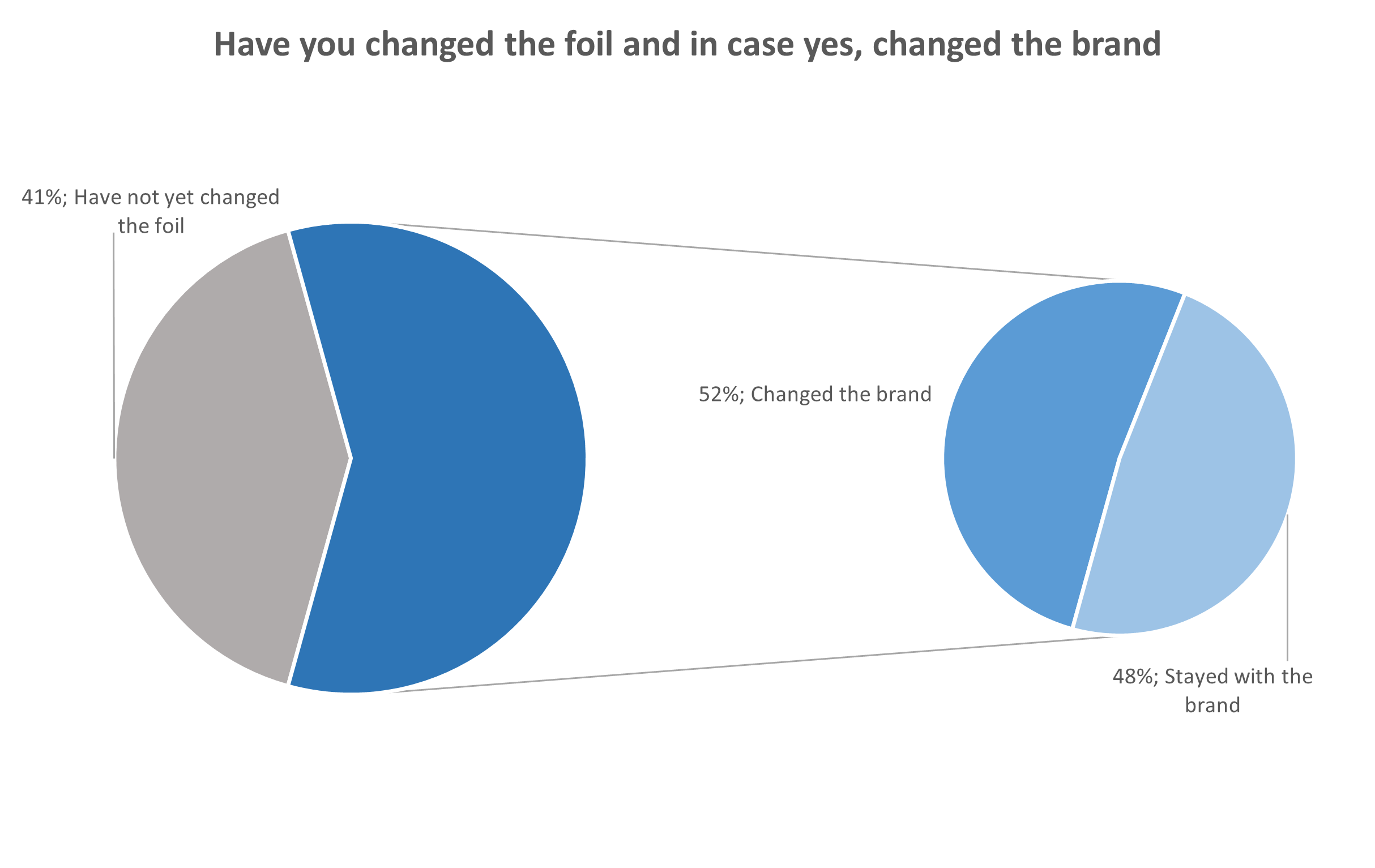
Well, we have to be aware that the results may are not 100% representative. However, we tried to find out if one or the other brand has a higher loyalty, means that people stay with the brand when changing from the beginner foil to the next level, more advanced foil.
In the following diagram we display the results of the participants who mentioned that they already changed the foil and if they stayed with the brand. The number in front of the percentage amount indicates the sample size, means that e.g. out of 28 foilers who had their first foil from Indiana, 57% stayed with the brand when deciding for the next level foil.

When talking about buying a pumpfoil set or putting a suitable set together, I am also often asked „what mast length should I go for?“. Well, there is no precise answer to that question and also depends on the personal preference of the rider. You can find some more information about factors influencing the decision for the mast length in the video „Short or Long Mast for Pumpfoiling“.
Nevertheless, we asked also the community what mast length they use.
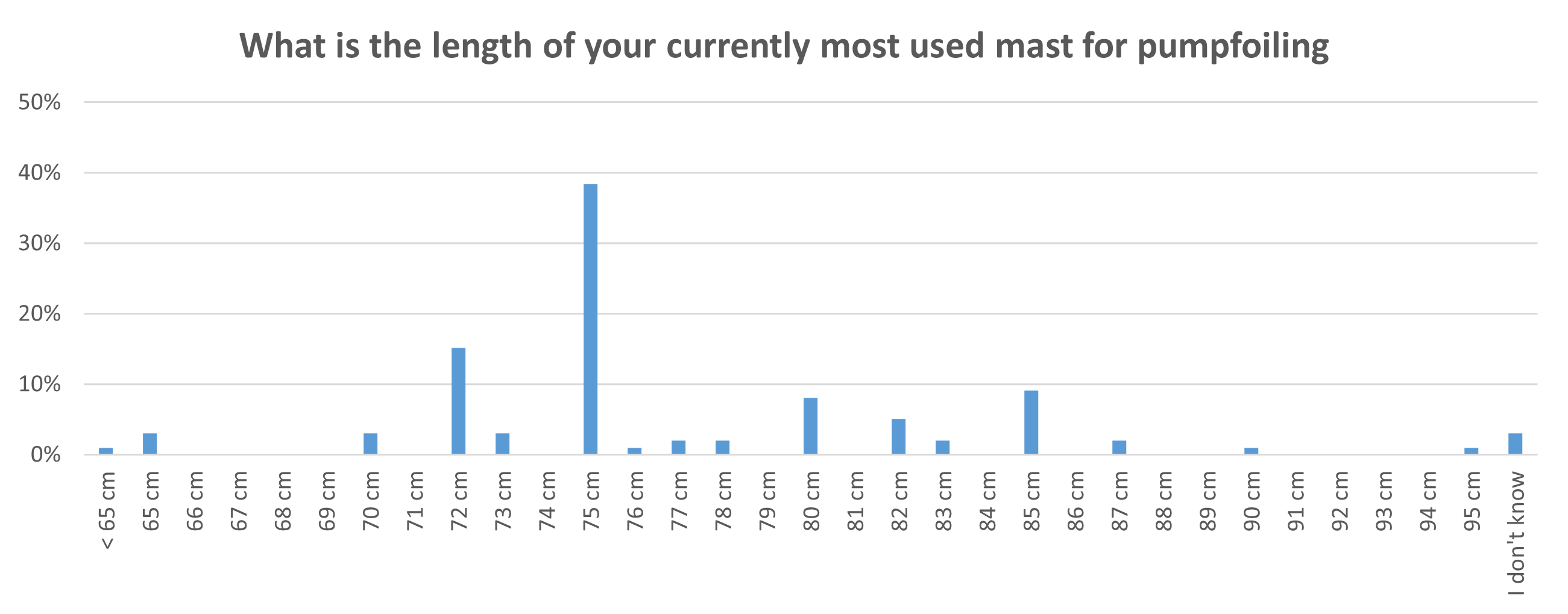
As we can see from the analysis of the results, a majority of the survey participants are using mast length between 72cm and 75cm, however, there are also quite a few using longer masts.
What are your ambitions when pumpfoiling
We already mentioned that deciding on the equipment is not only dependent on the pumpfoil level and the physical condition of the pumpfoiler, but also depends on the personal preferences of the foiler.
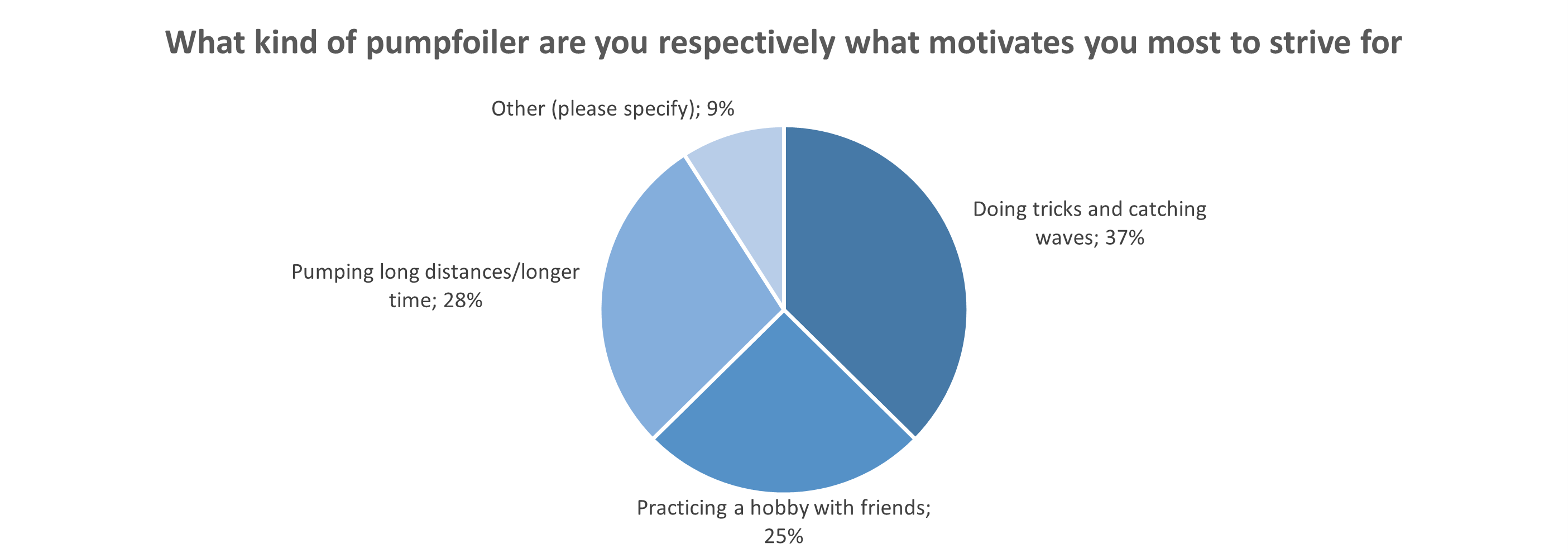
Do our survey participants also practice other foiling sports
Many pumpfoilers do not only practice pumpfoiling, but also enjoy other foiling sports like wing- or kitefoiling. One of the big advantages of pumpfoiling is, that you are not dependent on the wind and e.g. also do not need the space you need to launch a kite.
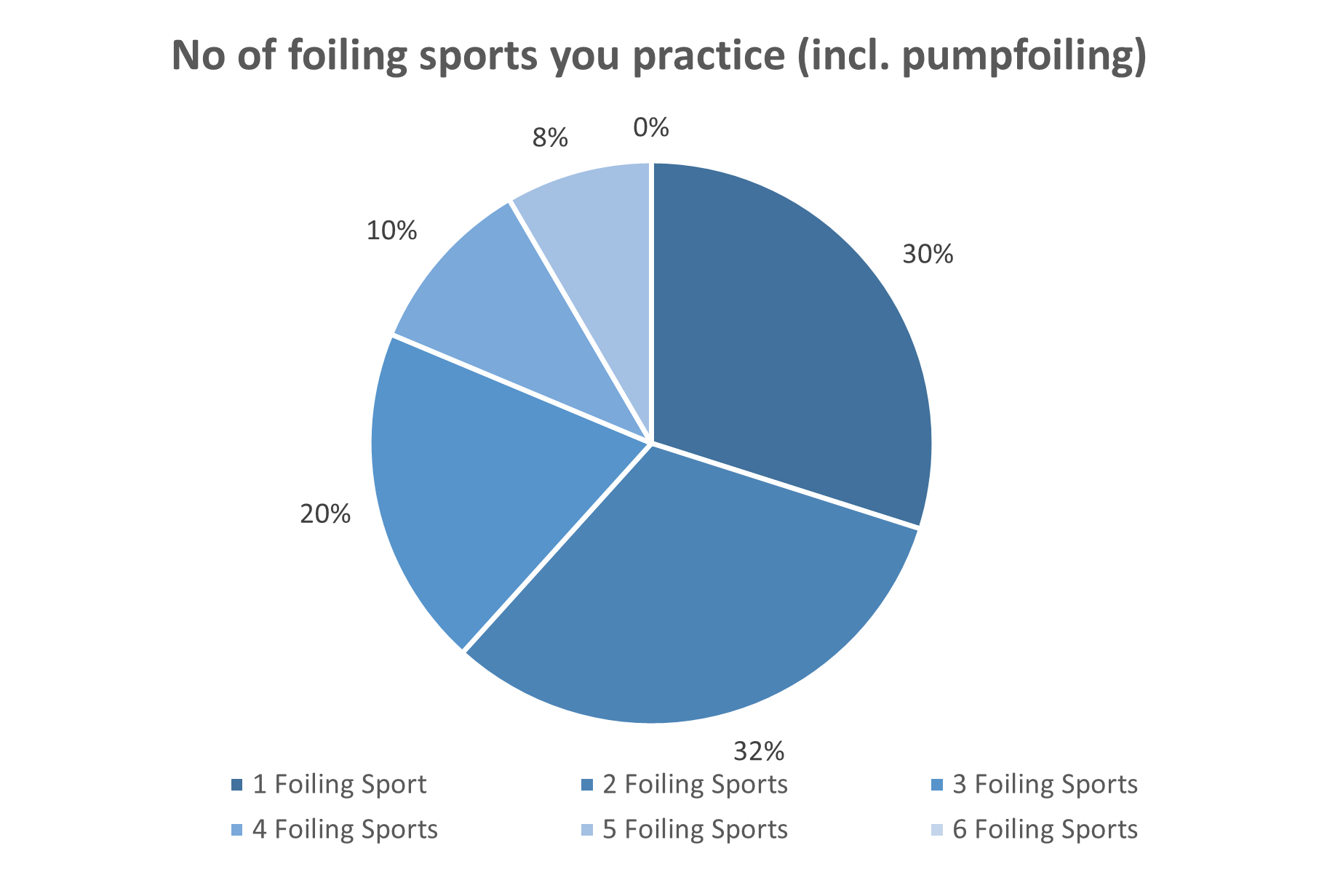
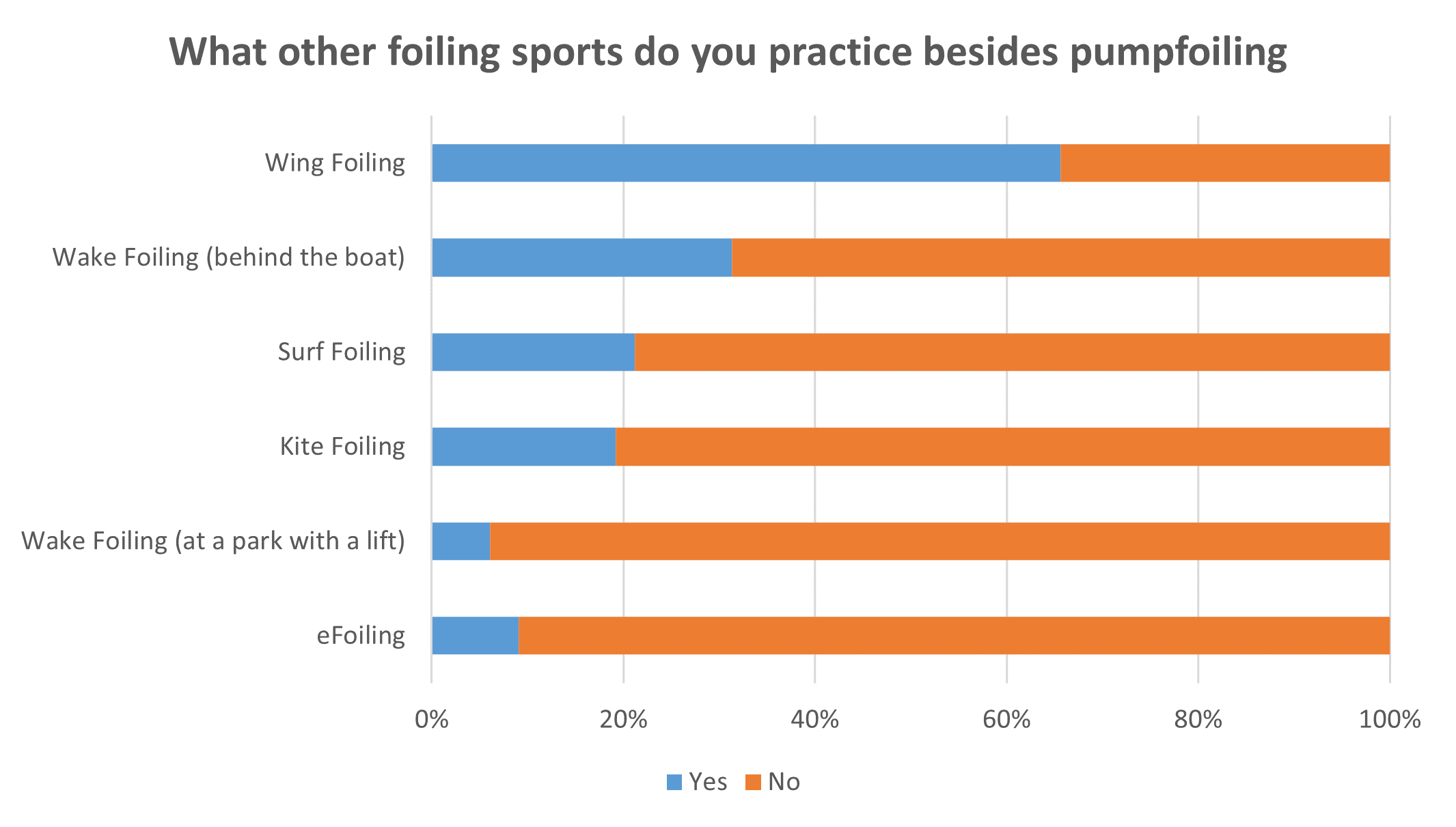
As we can see from the answers from our survey participants, only 30% practice only pumpfoiling. The number one sport besides pumpfoiling (at least for the pumpfoilers) seems to be wingfoiling, followed by wake- and surffoiling.
How dangerous is pumpfoiling
Having talked about what it takes to start with pumpfoiling, how difficult it is and also what material is required, there is one more important aspect: Safety
Practicing pumpfoiling is associated with many risks. Besides risks associated with any sport taking place on and at the water, there are also risks due to the equipment you are using. Looking at e.g. at the foils, they are made from stiff material and also have sharp edges. But also the boards are not made from soft material and also falling onto the board can sometimes be painful or even lead to an injury. Therefore, we also wanted to cover that aspect in our survey.
First of all, we were curious to find out, if the participants in our survey wear protective equipment.
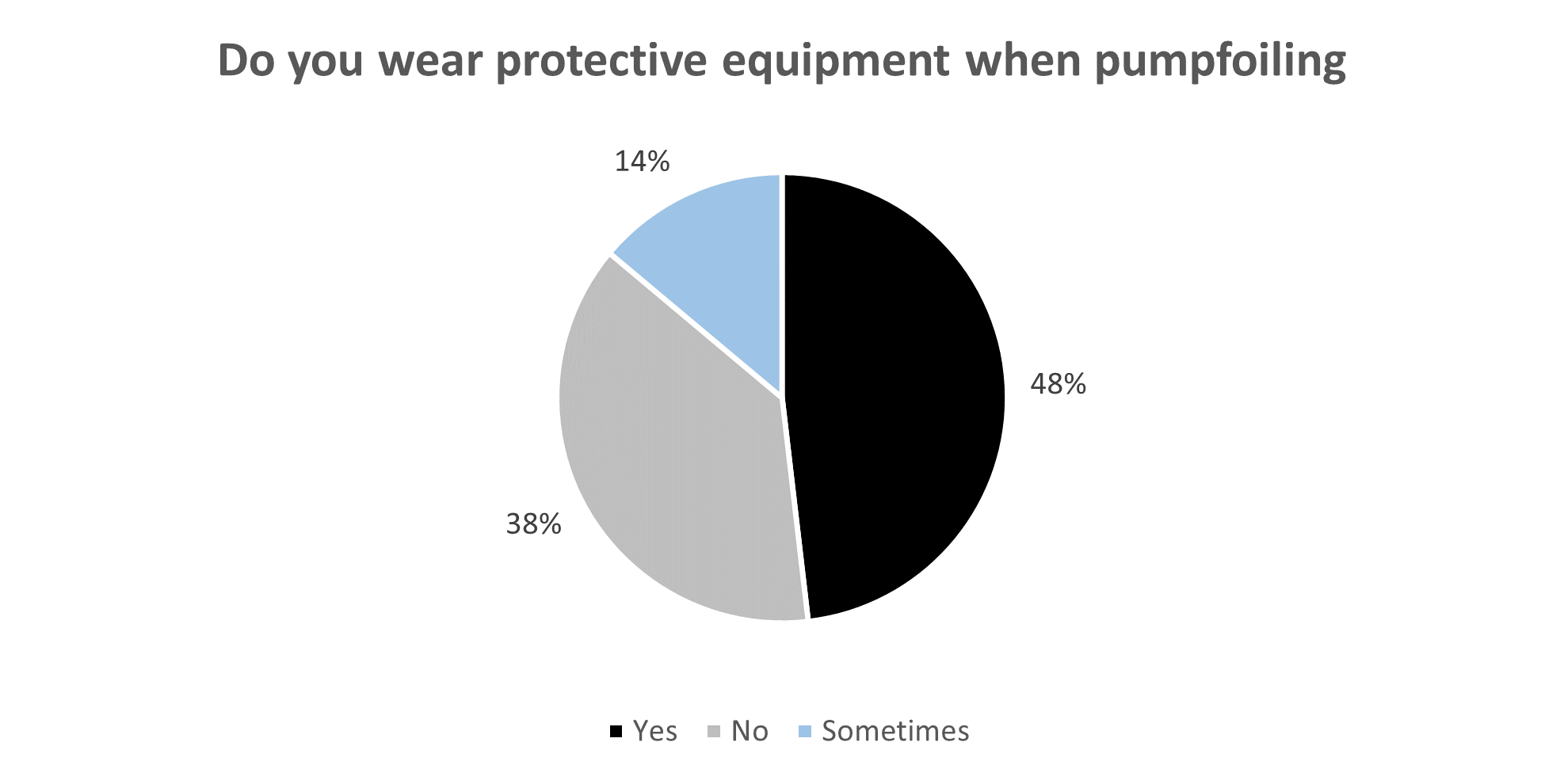
62% of our survey participants wear at least sometimes a kind of protective equipment. Only 38% mentioned that they do not wear protective equipment.
Looking more into the details, we can see that helmets and wetsuits are the most used protective equipment.
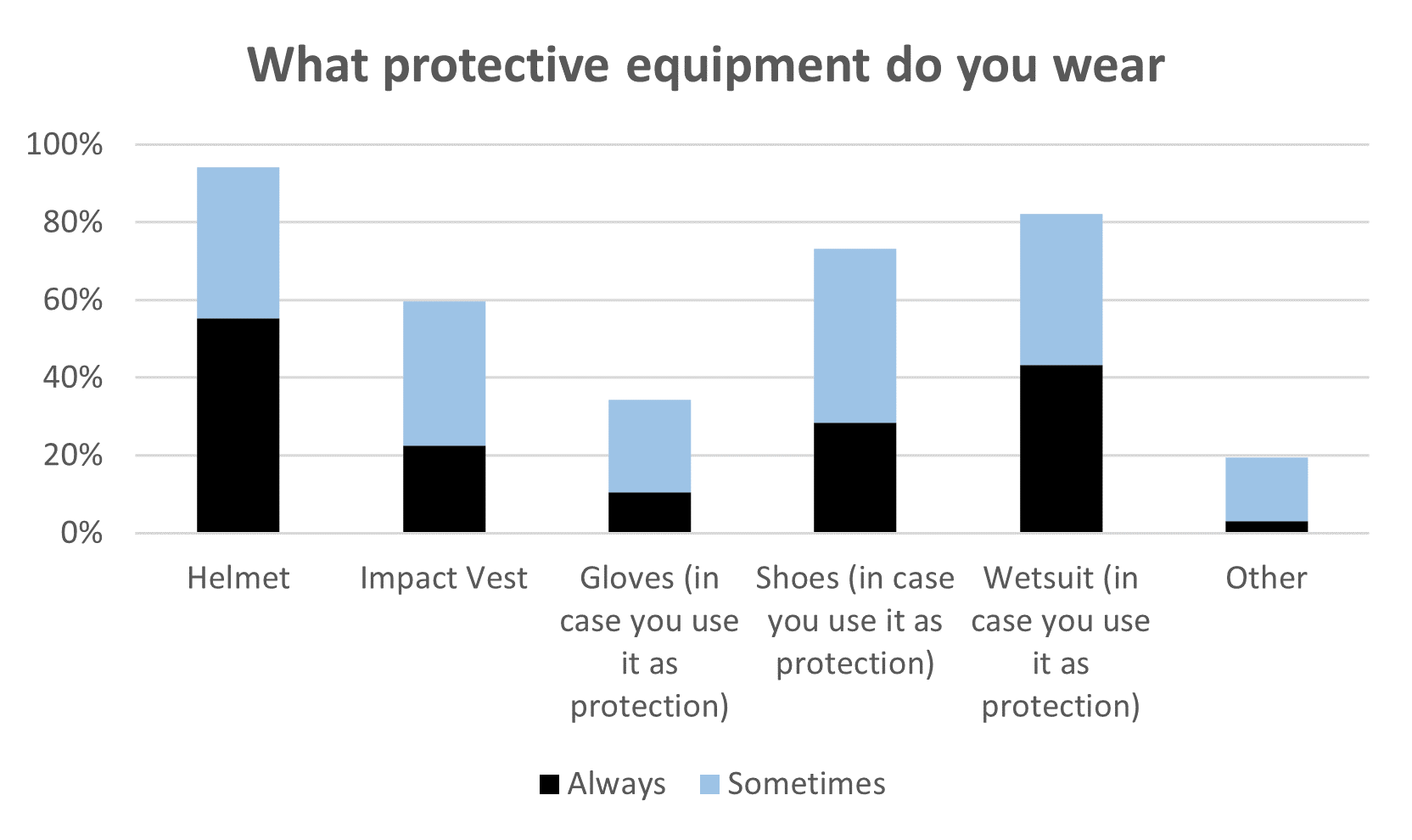
Wearing protective equipment obviously has the goal to avoid injuries, although not every injury can be prevented even when wearing some protective equipment. Last year we published an article about how dangerous is pumpfoiling and looked also in the injury frequency rate. In this years survey we also asked the participants specifically if they ever suffered an injury while pumpfoiling.
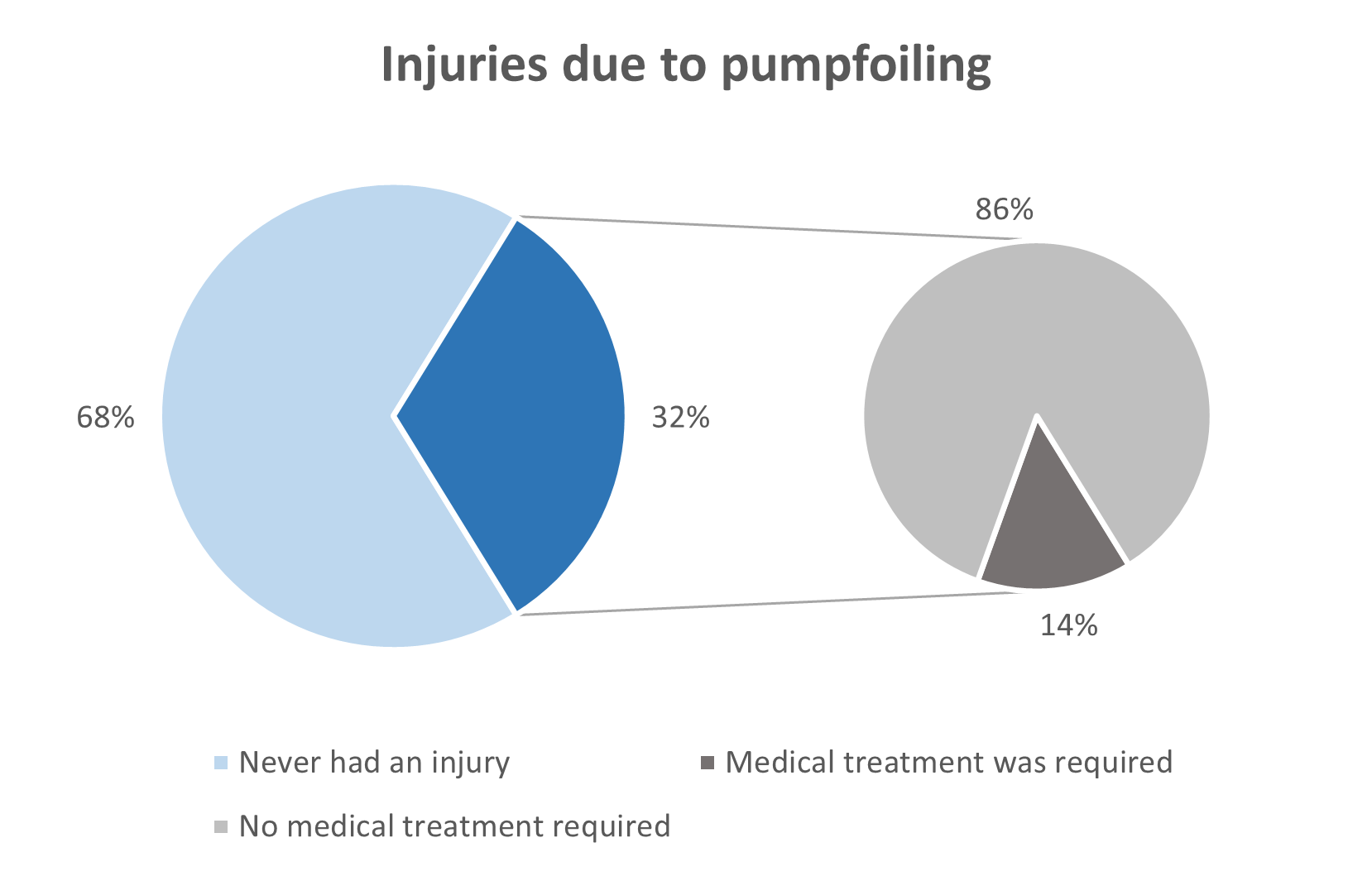
32% already have suffered from an injury. Luckily, most of them were minor injuries and only 14% of the injuries required medical treatment. This becomes also visible when looking at the kid of injuries.

Most of the injuries where bruises and scratches, injuries which you usually can prevent by wearing a wetsuit, shoes and gloves.
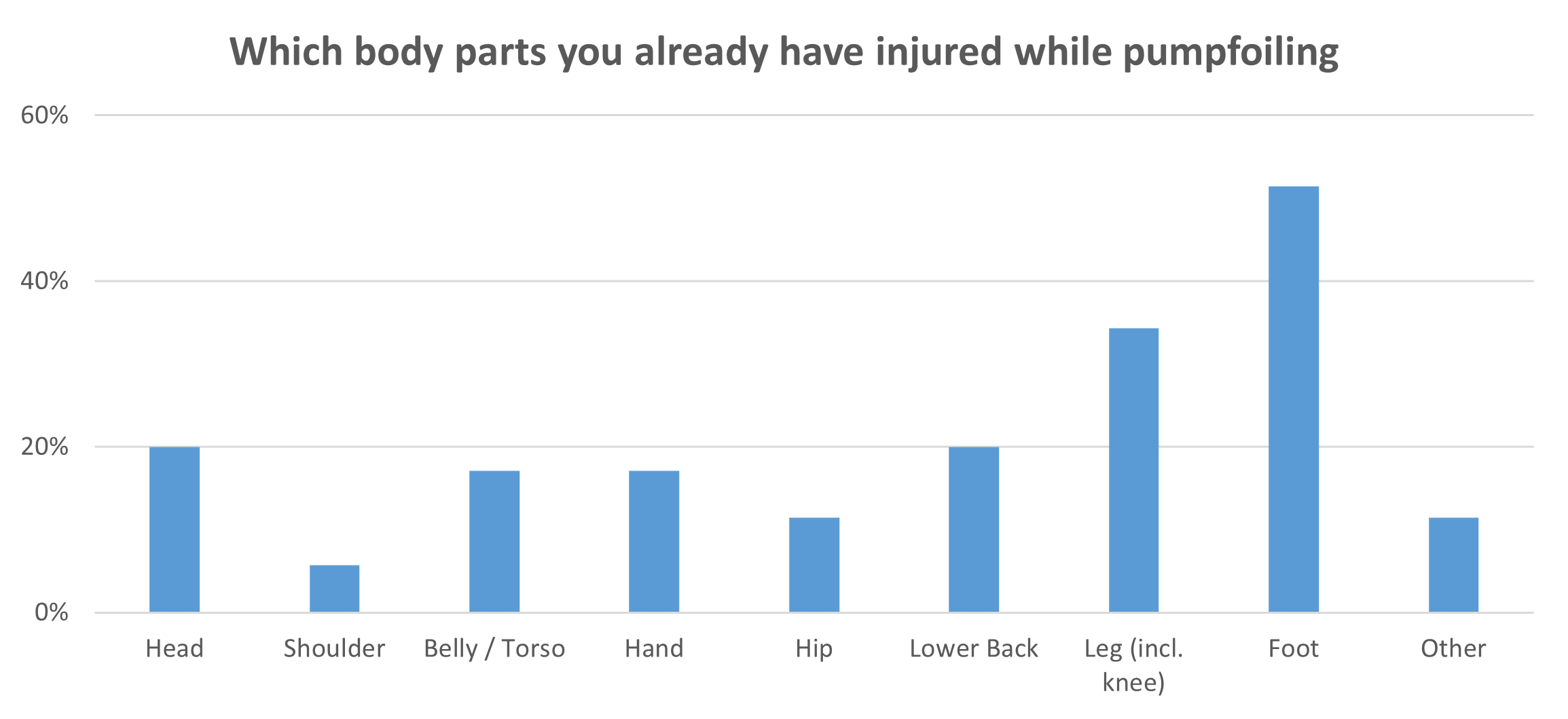
Drilling down into which parts are most exposed for injuries, we can see, that foot and leg injuries are most common, followed by head and belly/torso injuries.
Although, we can take as a conclusion that sever injuries are very rare, it is recommended to be careful and wear protective equipment.
Recommendations for beginners
As beginners as well as more experienced pumpfoilers took part in our survey, we were for sure curious to learn from their experience and also asked them, what their recommendations are for newbies who like to or just have started with pumpfoiling. In the following diagram you find their answers. Please note that we could not reflect all feedbacks with the exact wording and had to do some grouping.
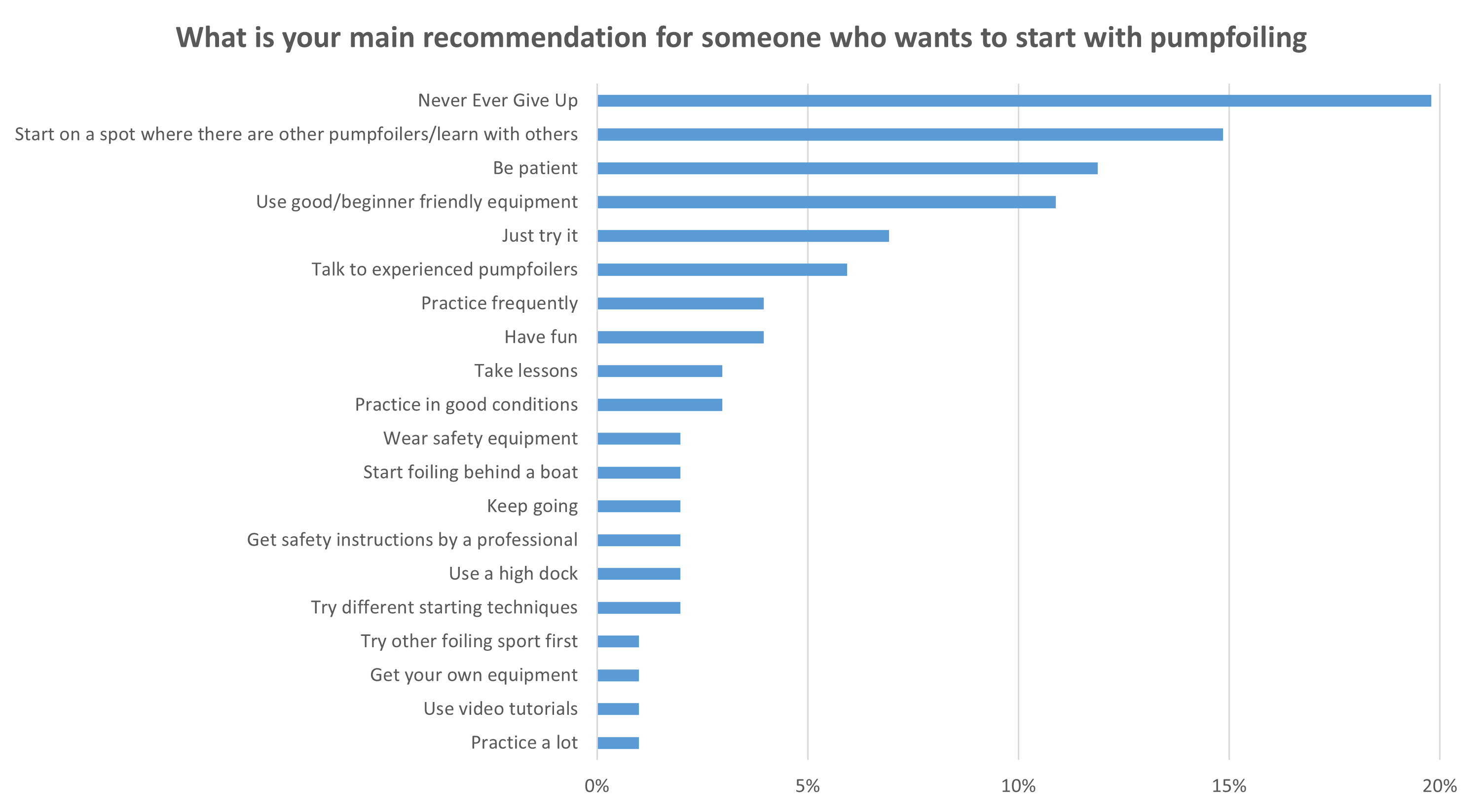
Final words
First of all, I would like to thank all the participants of the survey who shared their insights. The goal of this survey was to learn and share – one of the key elements of every community. The responses to the questions in this survey have one more time shown that pumpfoiling can be challenging – yes sometimes even frustrating – but also very rewarding, once you manage the first pumps, then manage the first turns and later on work on the records for your personal longest pump.
The section about the material used by the pumpfoilers is reflecting the developments that are currently being observed in the market. On a regular base, new wings, fuselages, masts and boards are launched by different brands which also lead to new possibilities for the foilers. By sharing the information about the foils used by beginners and more experienced foilers, the readers of this survey hopefully also get some more ideas and may even help when they decide for their own equipment.
Looking at the questions related to safety, we should be reminded that pumpfoiling is a fantastic sport, but also comes with some risks. Therefore, it is recommended to assess by everyone her-/himself, what safety equipment should be used.
Concluding with the recommendations for beginners, newbies hopefully find some hints how their start into pumpfoiling can be made easier.
Thanks to all who supported this survey and wish you safe and happy foiling sessions!
We reserve all rights in this article and for the contents contained therein. Reproduction, use or disclosure in third party documentation, also partially, without express authority is strictly forbidden. © 2024, pumpfoilers.ch, contact@pumpfoilers.ch, all rights reserved

